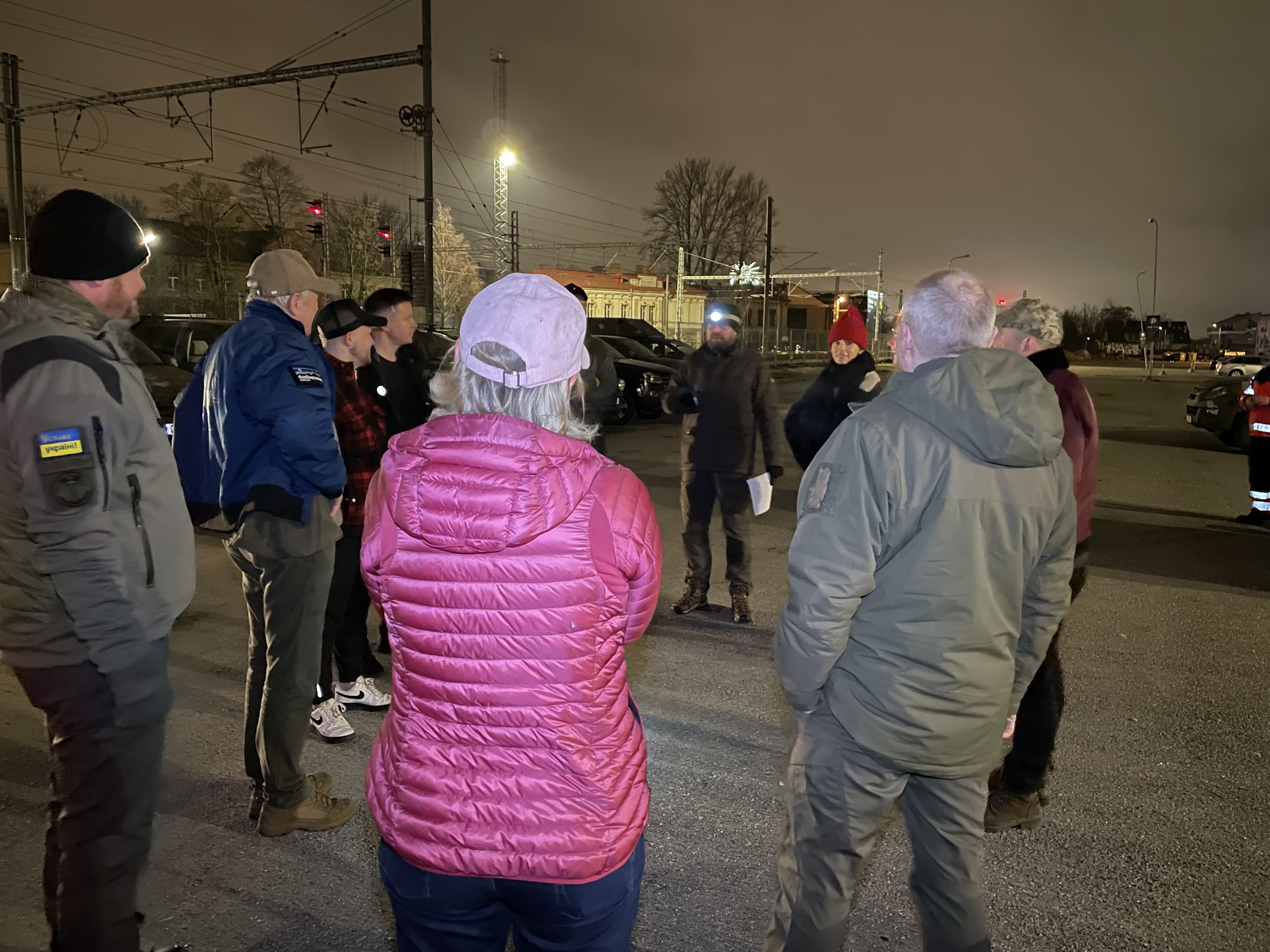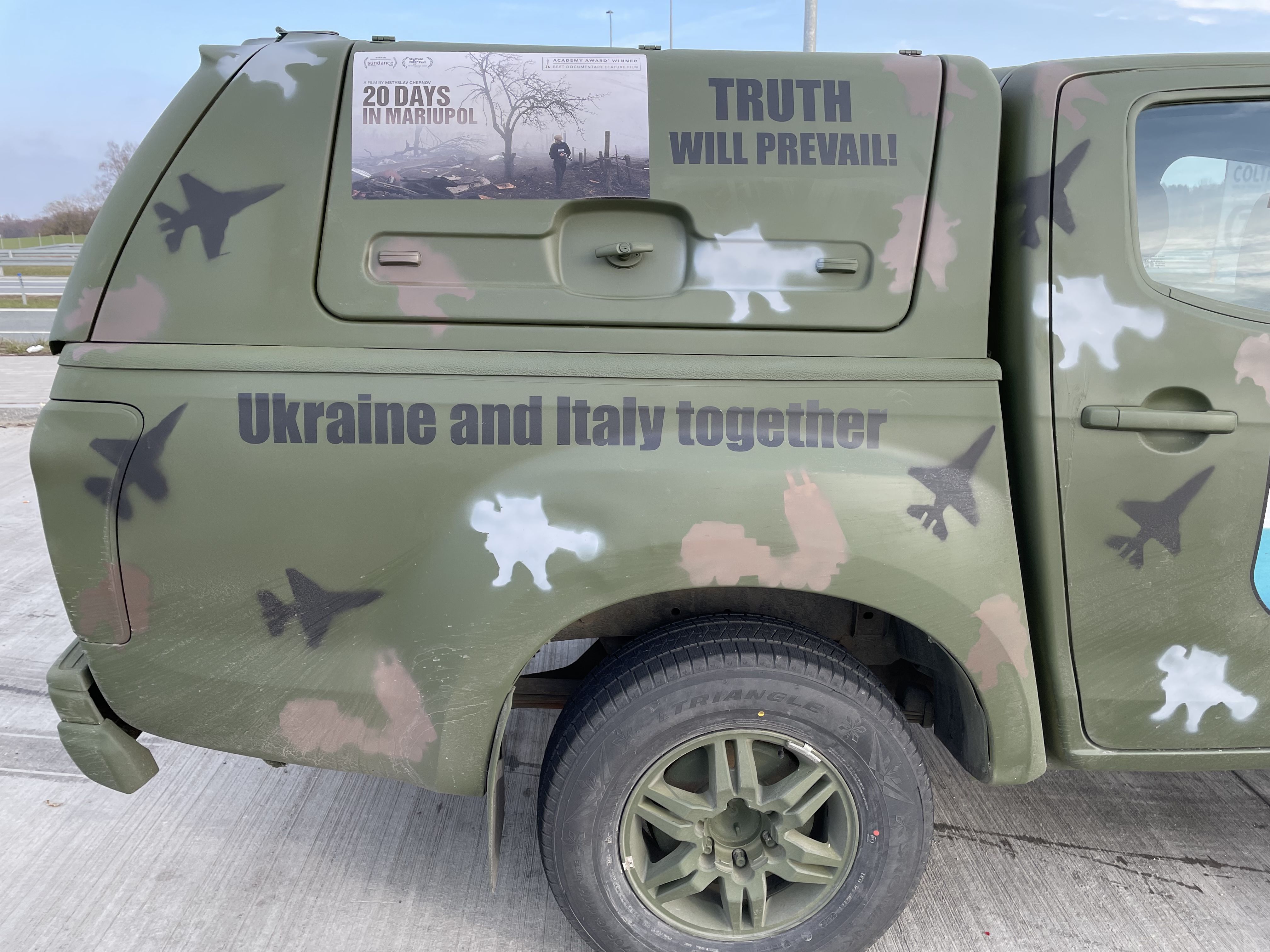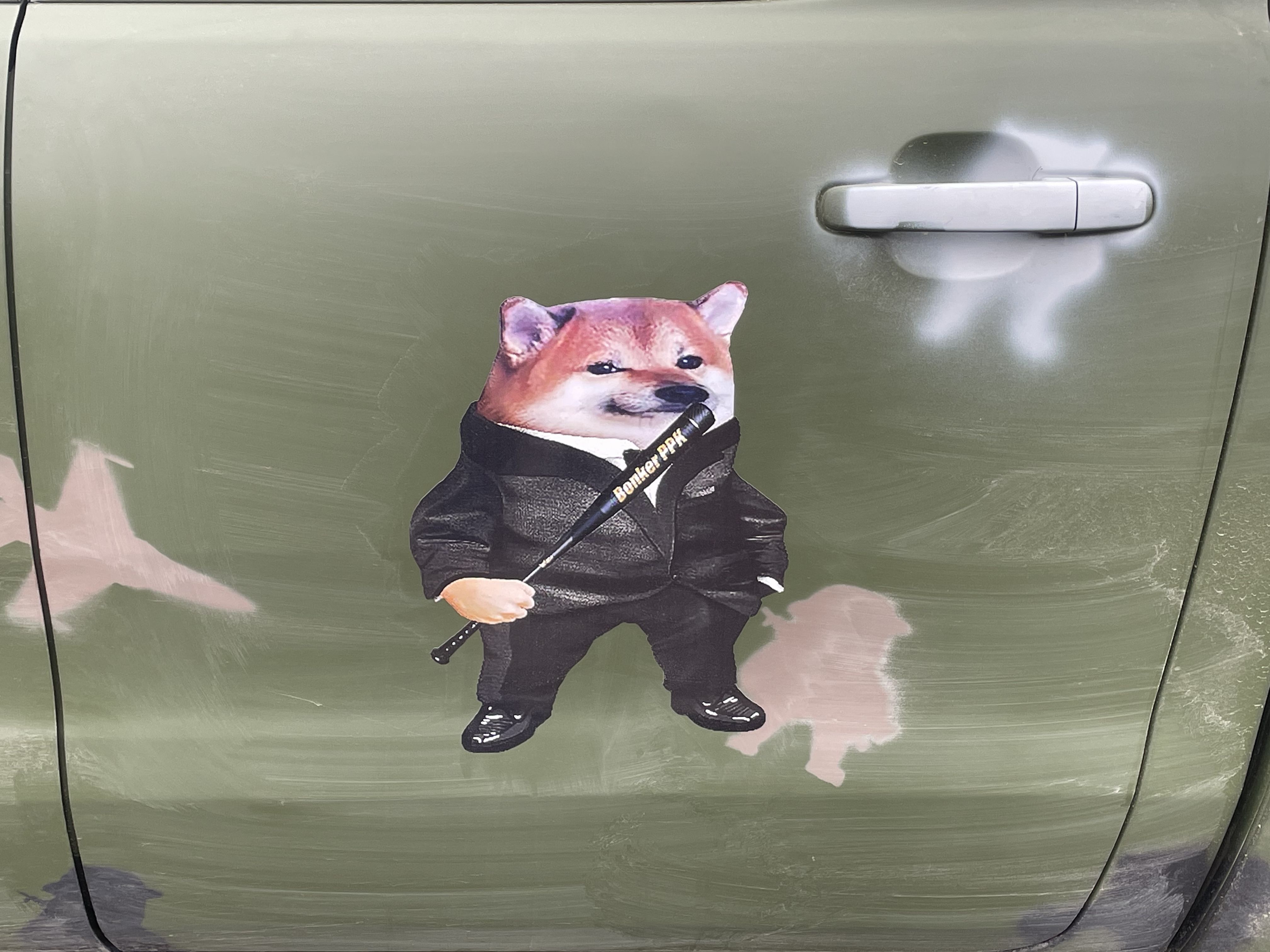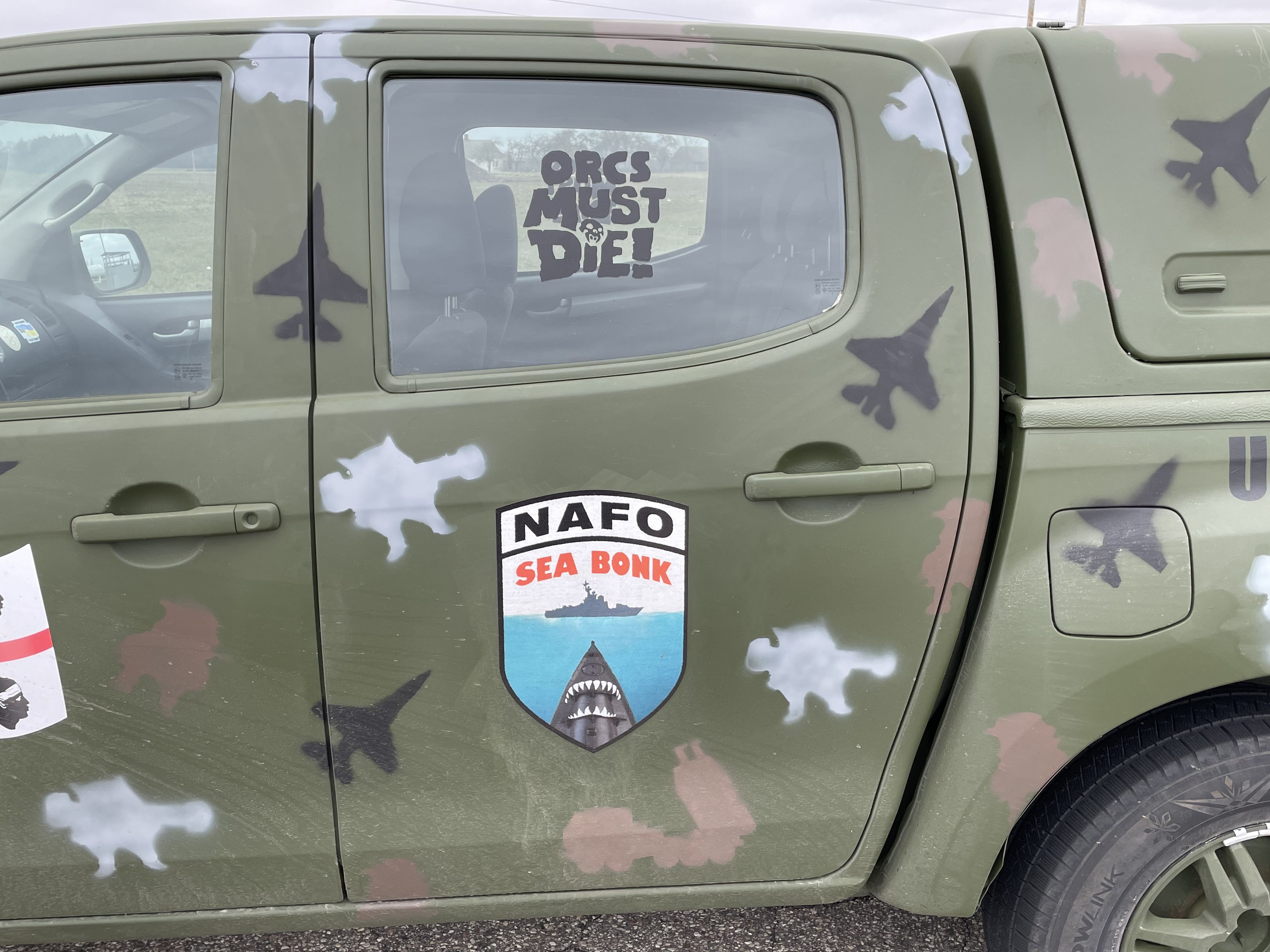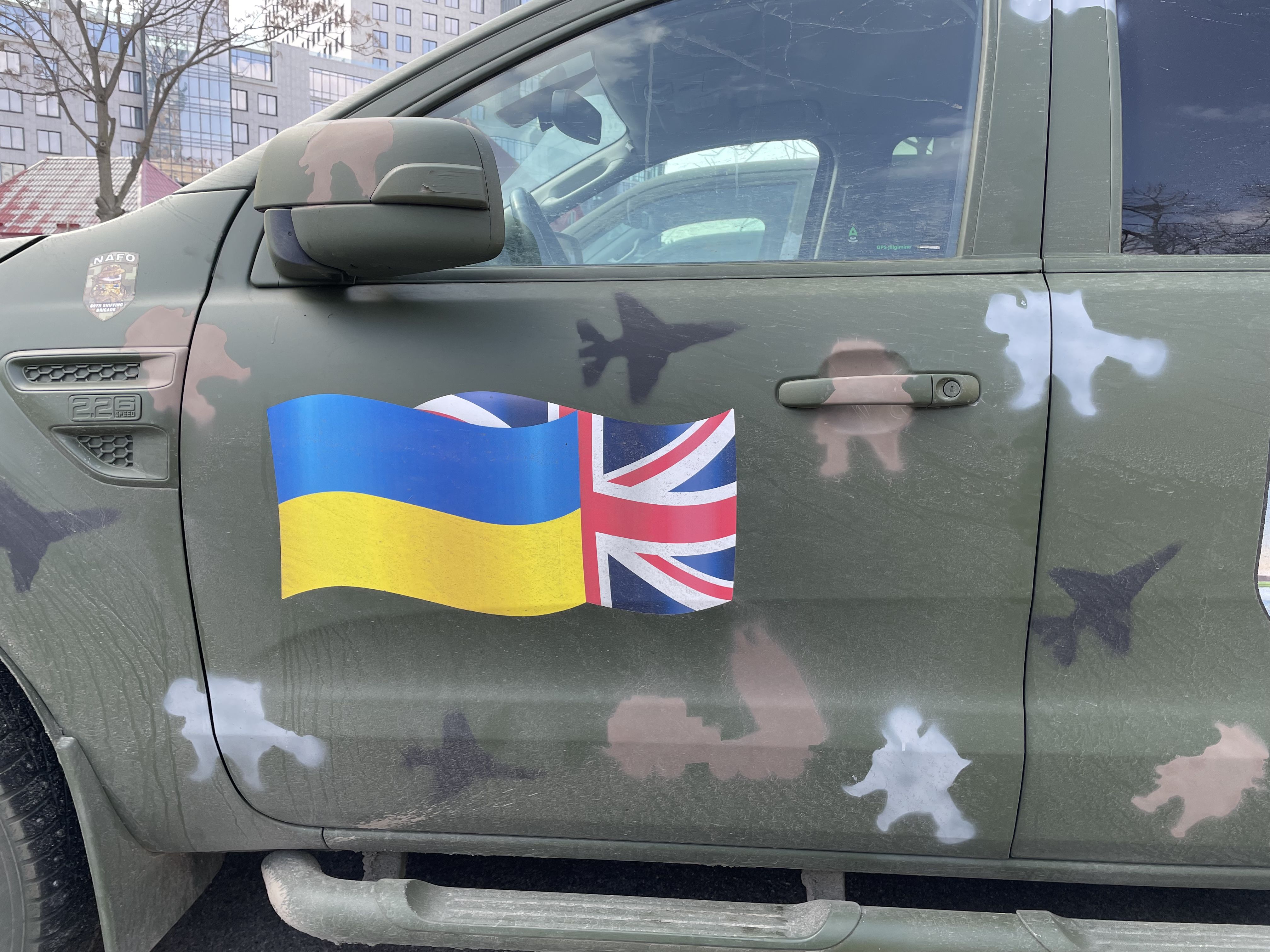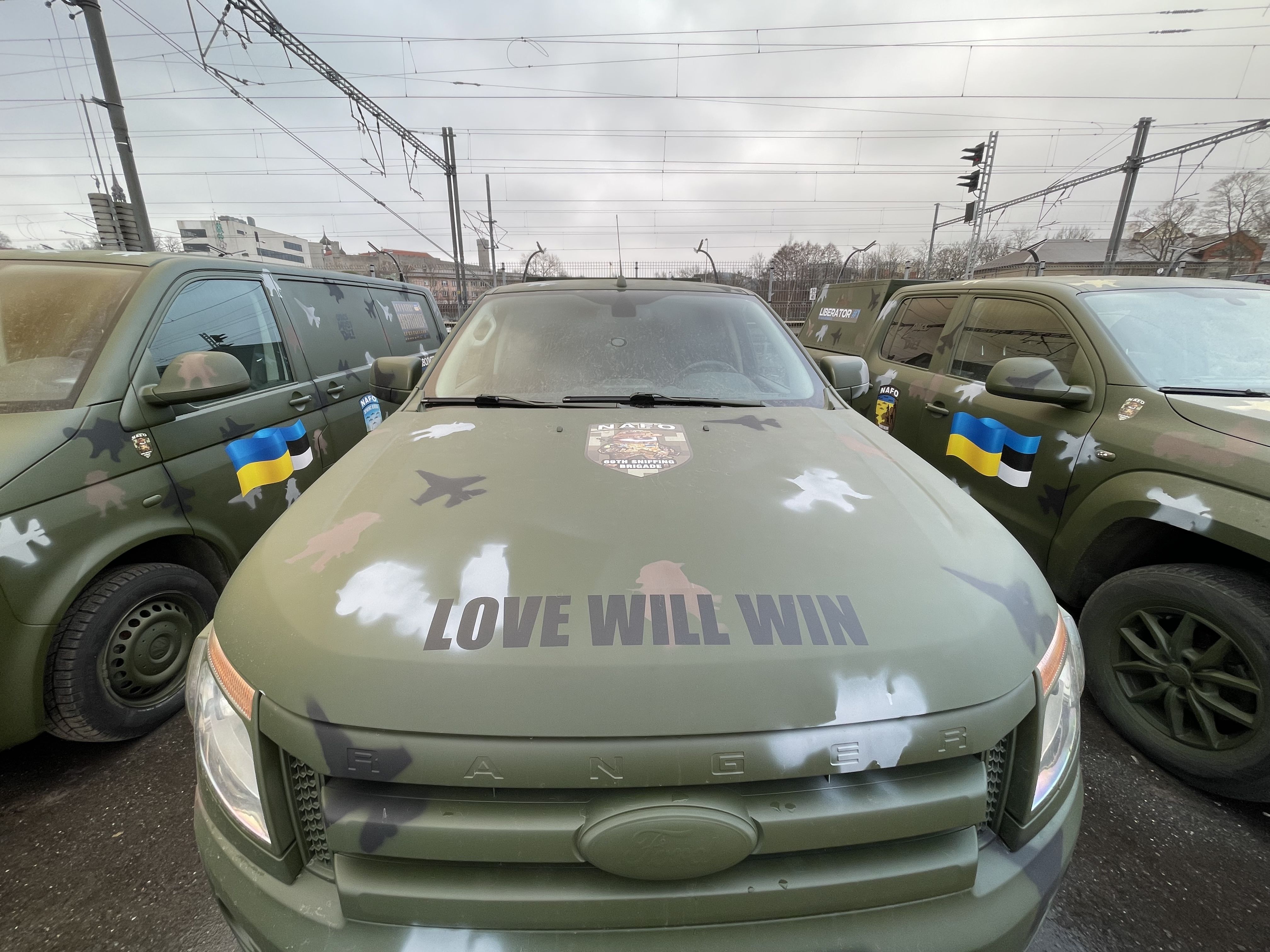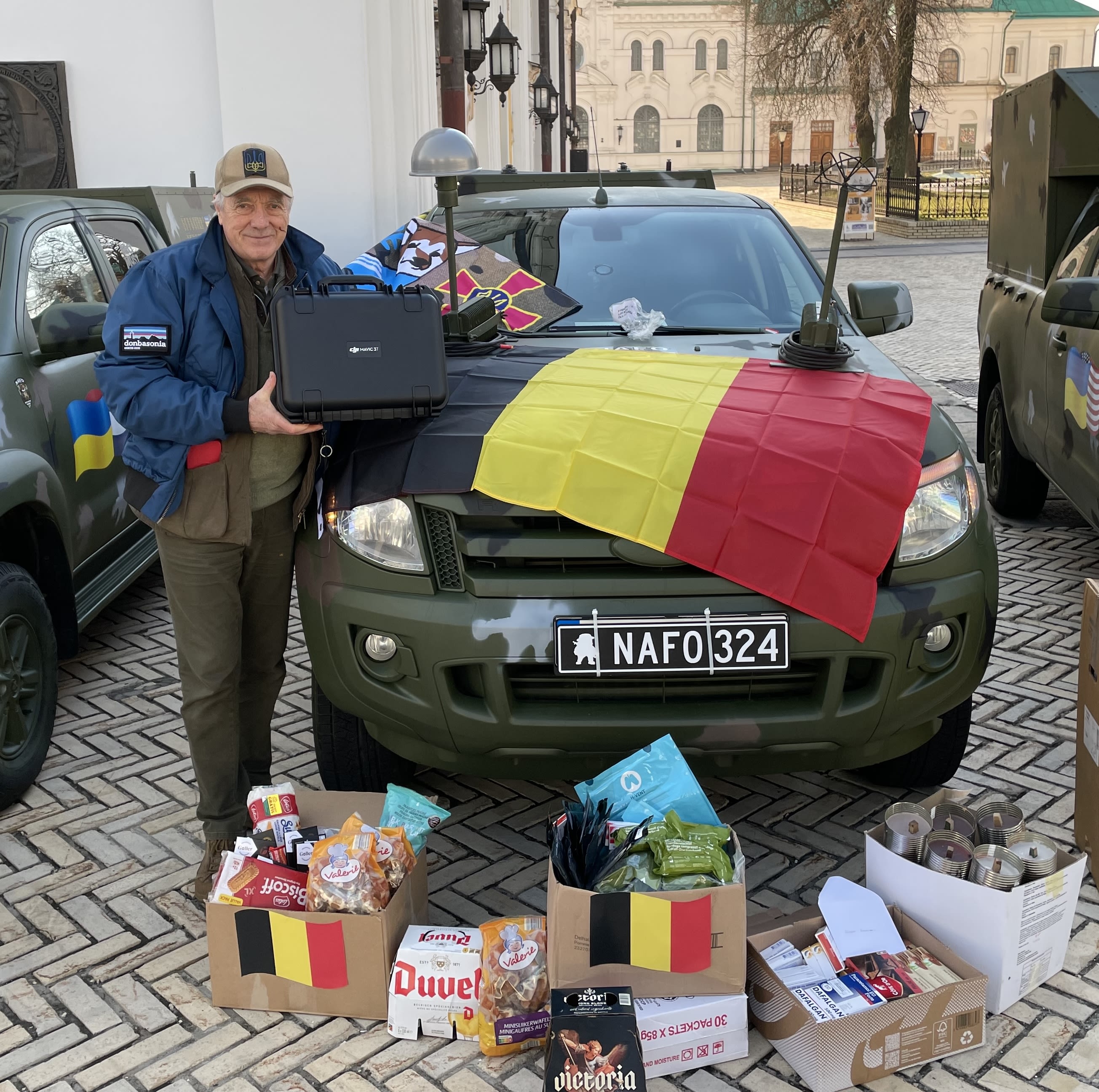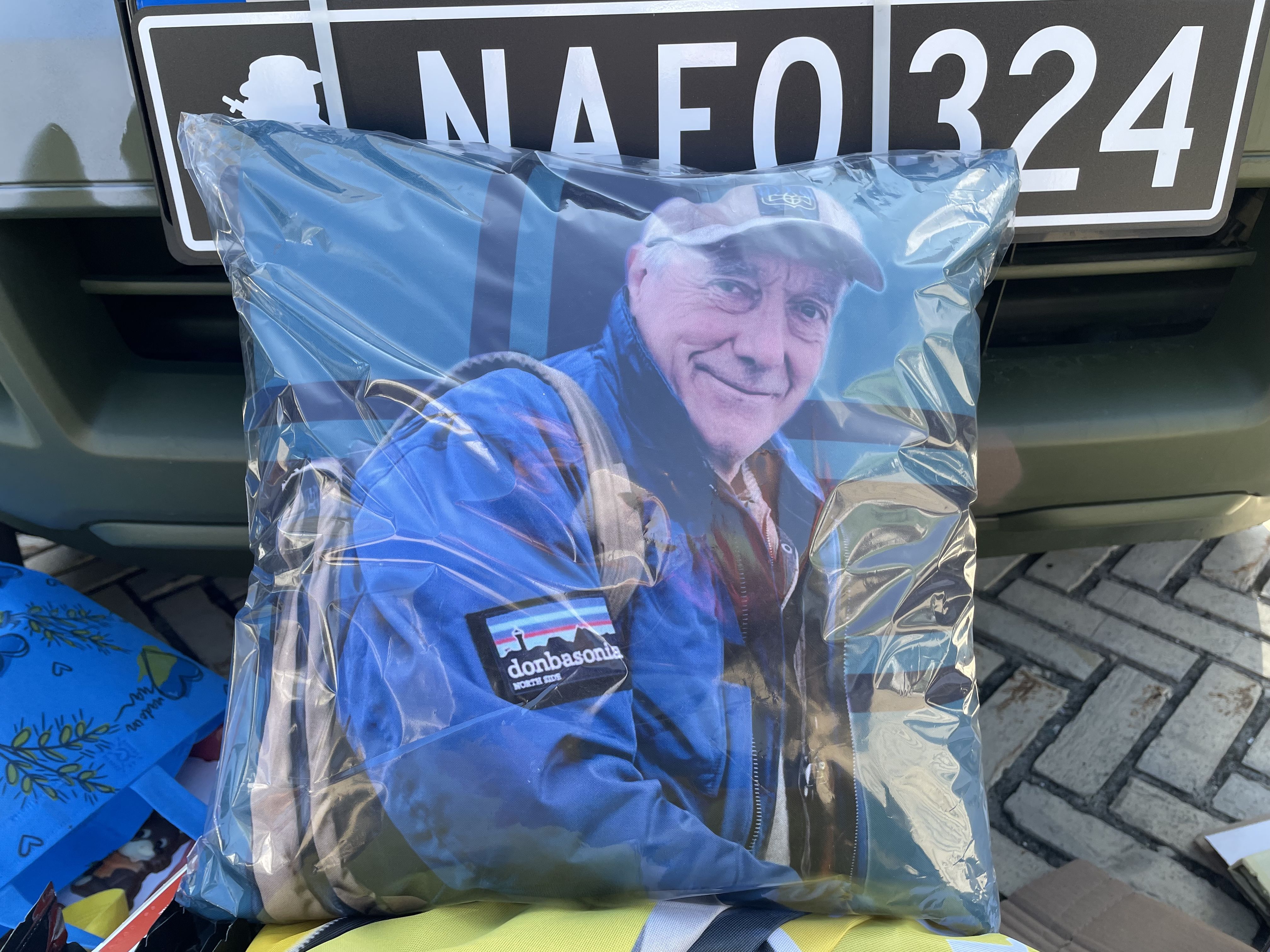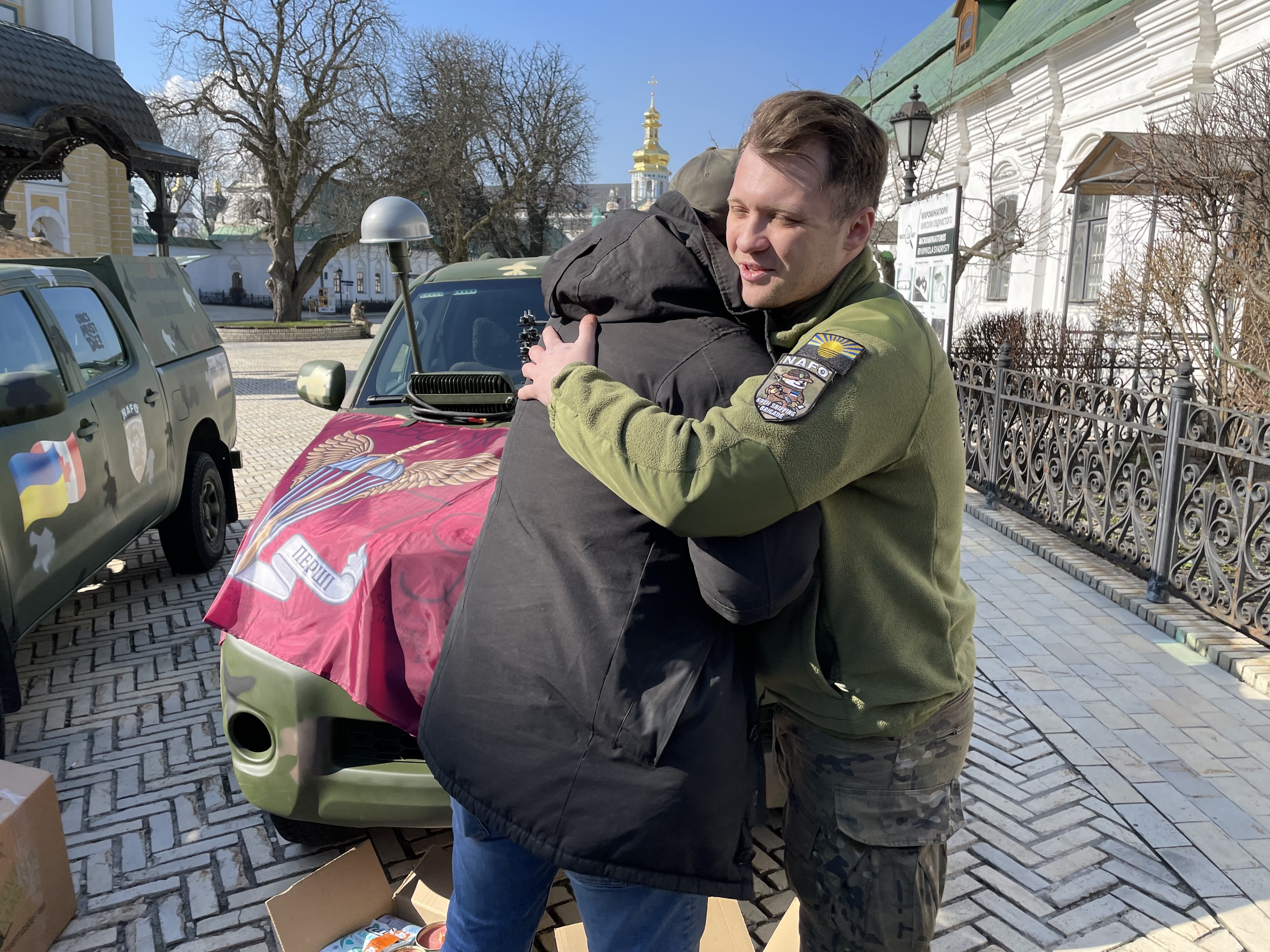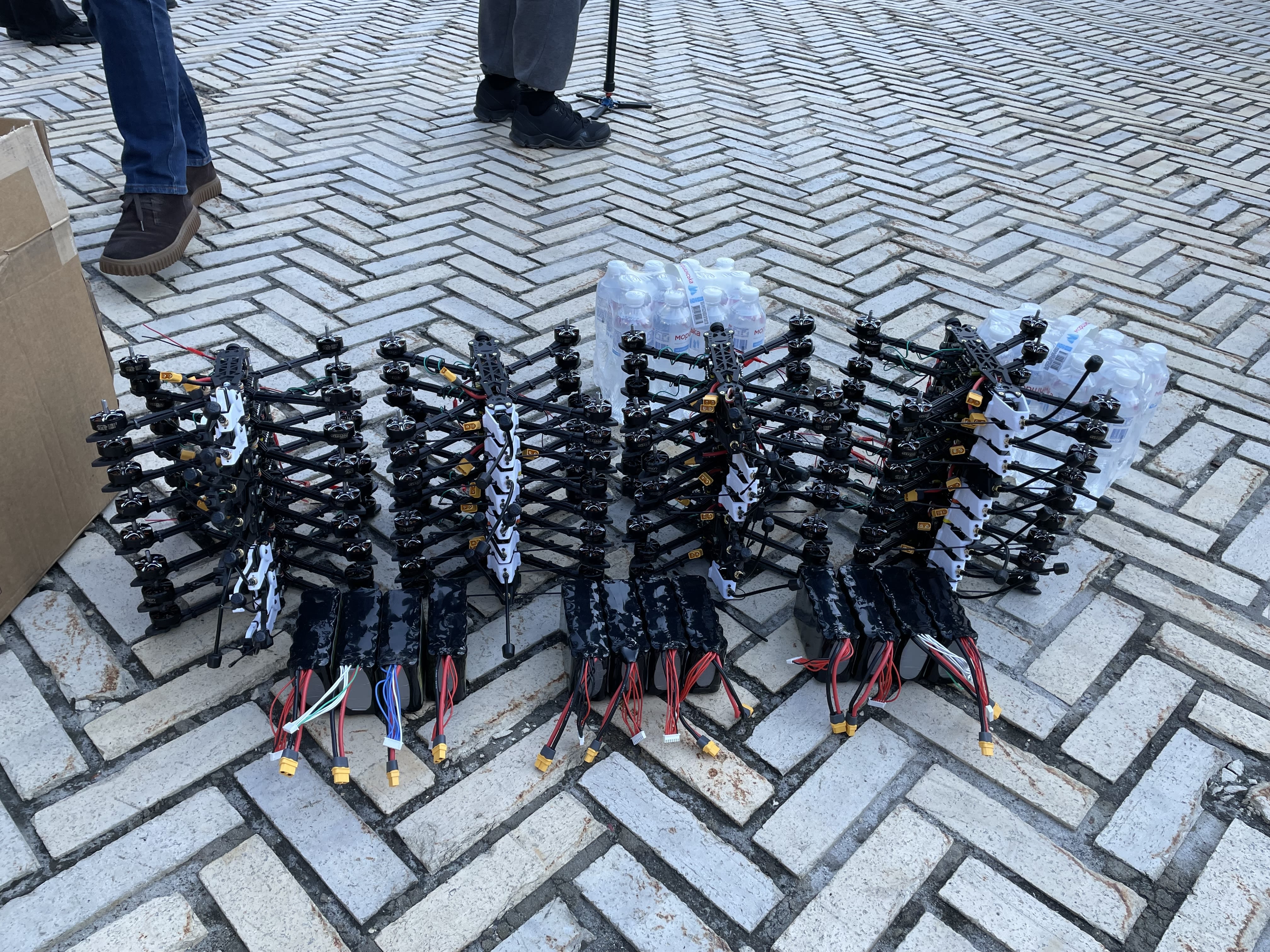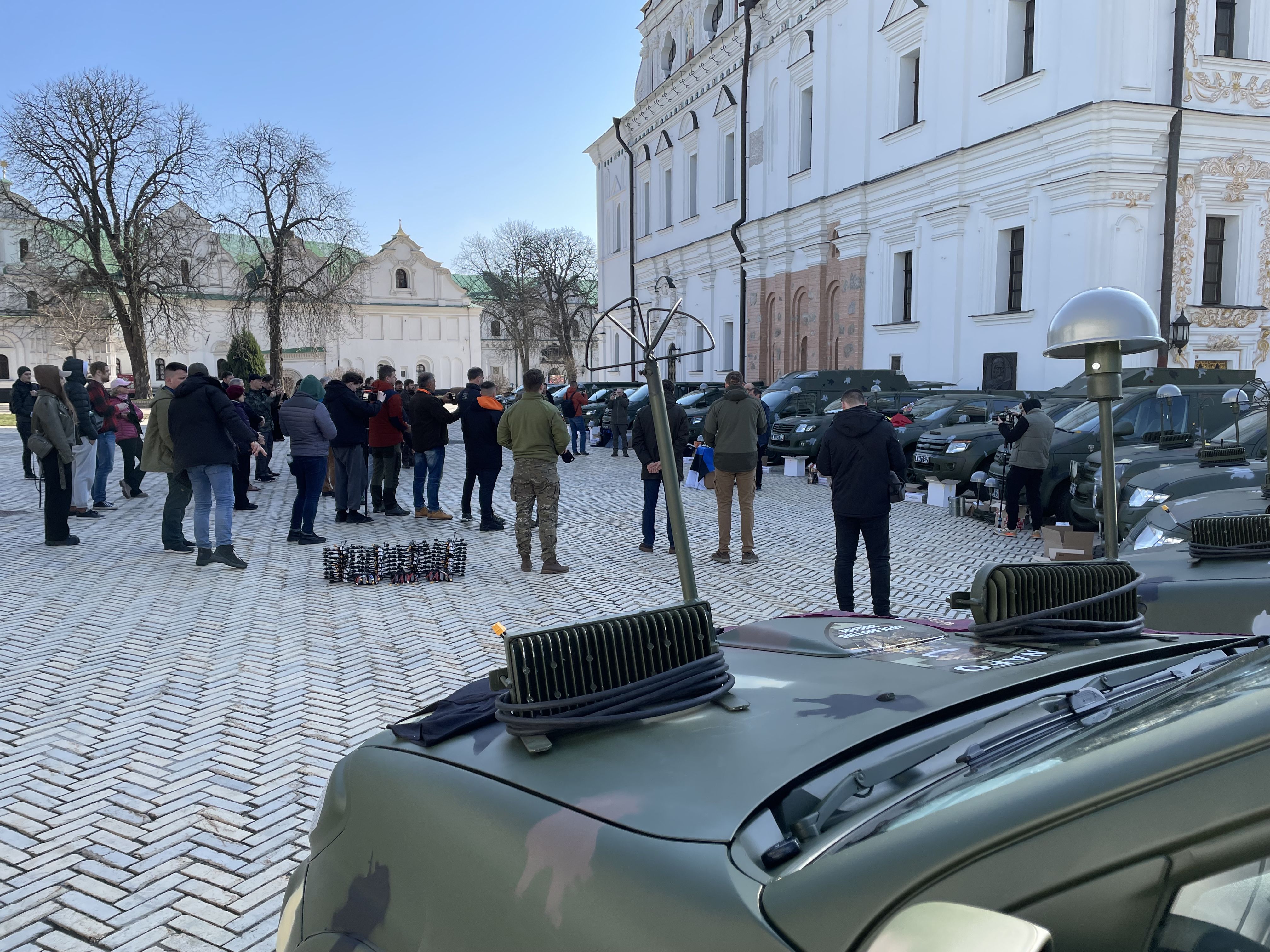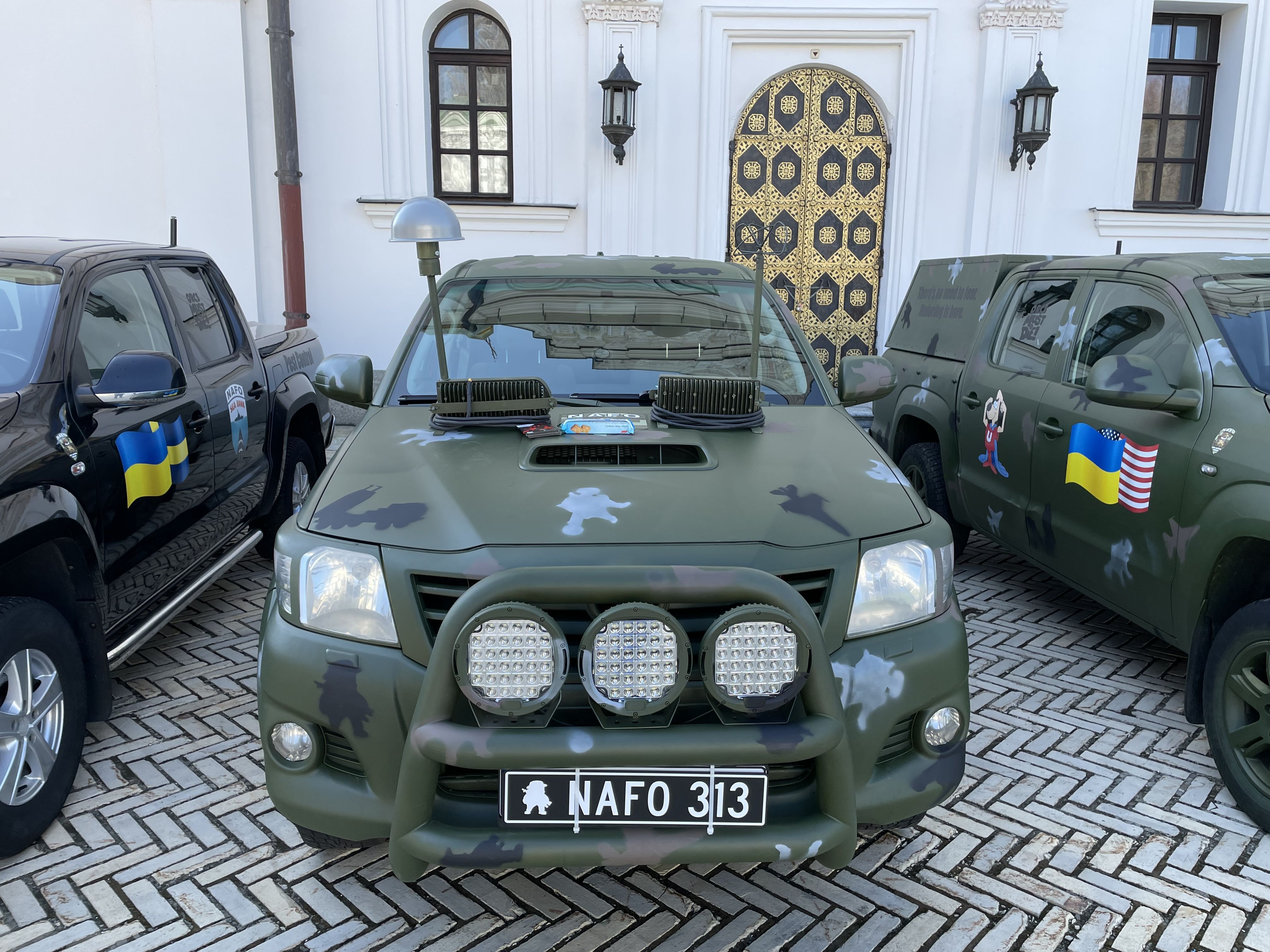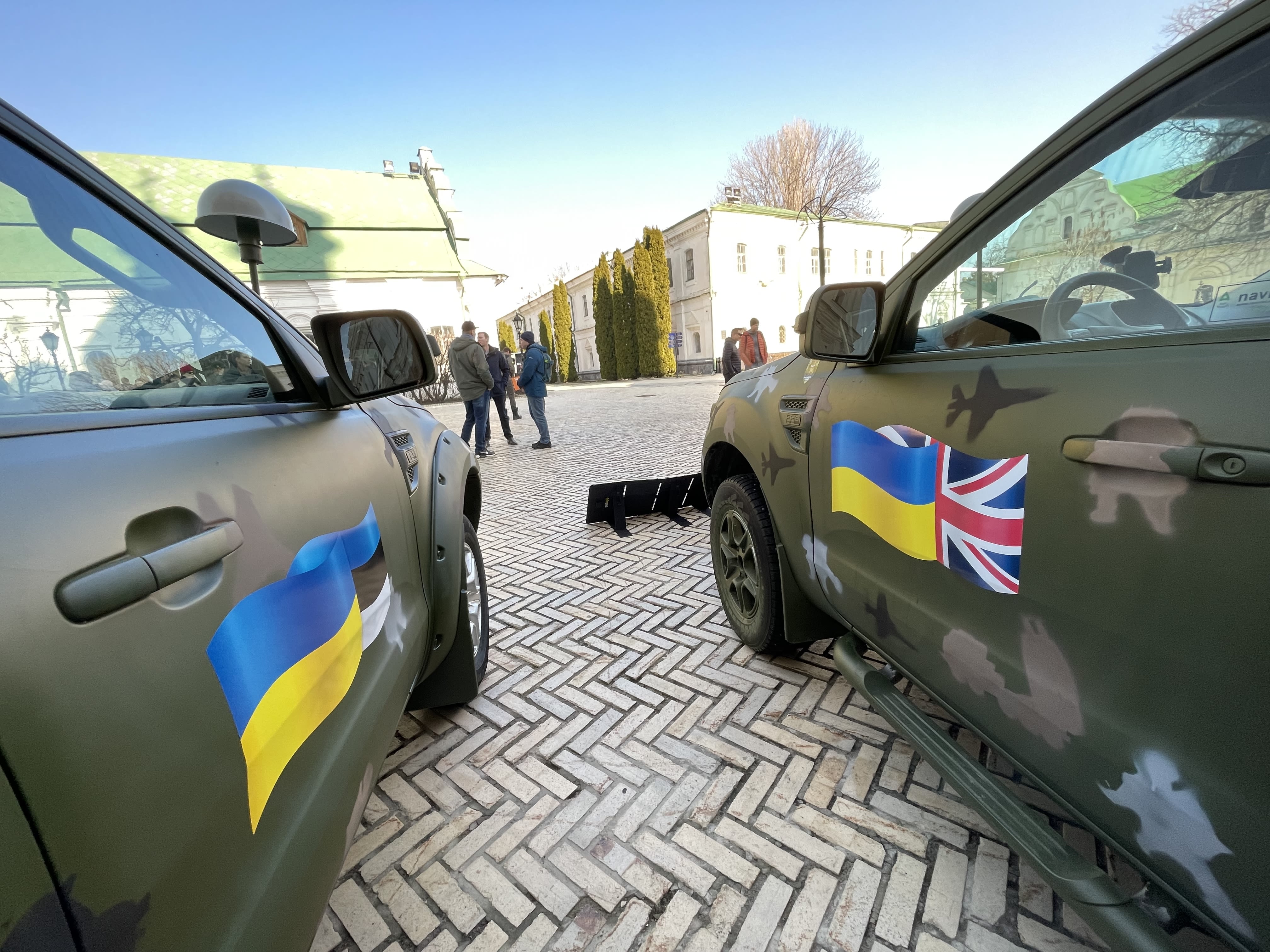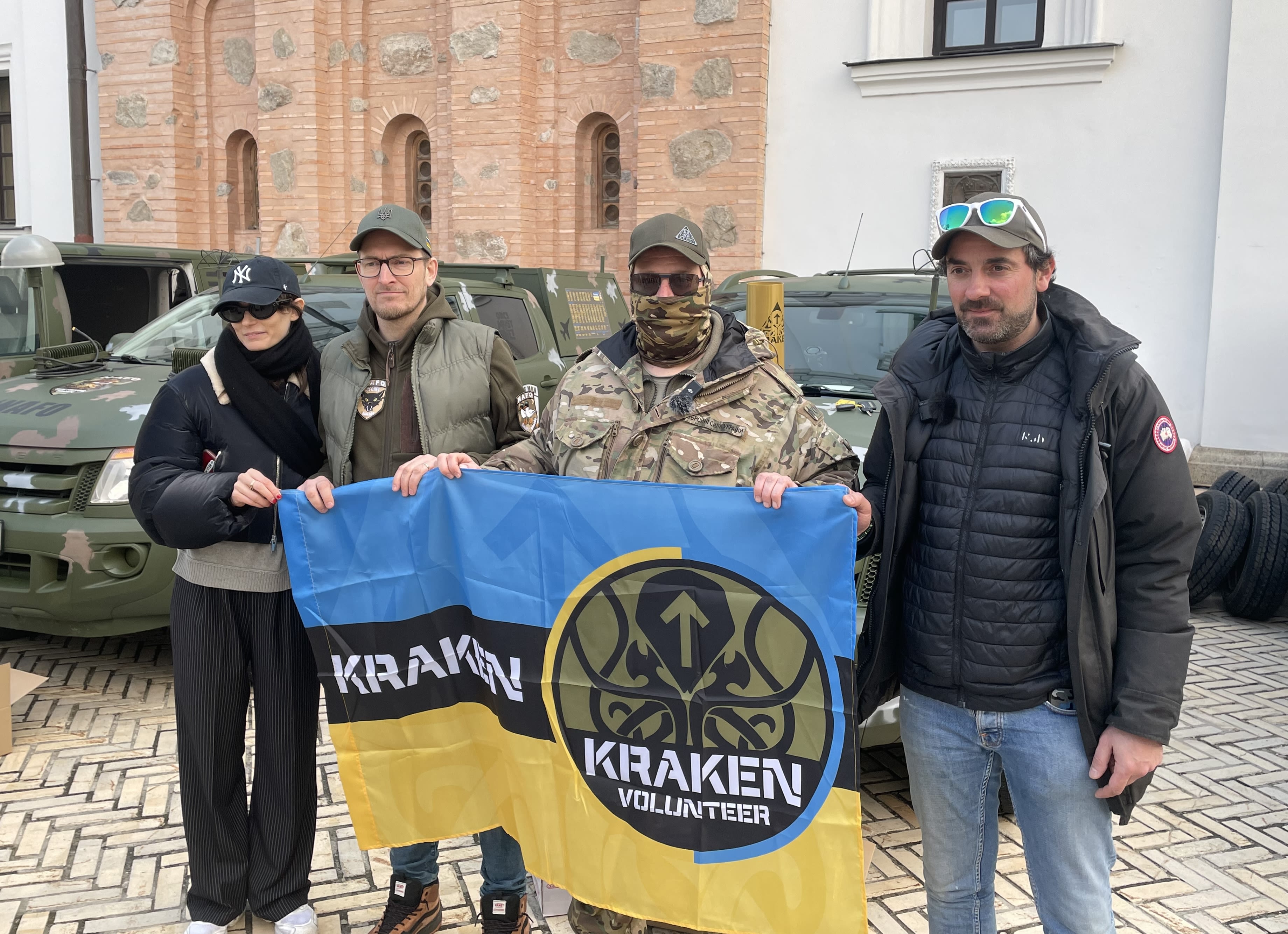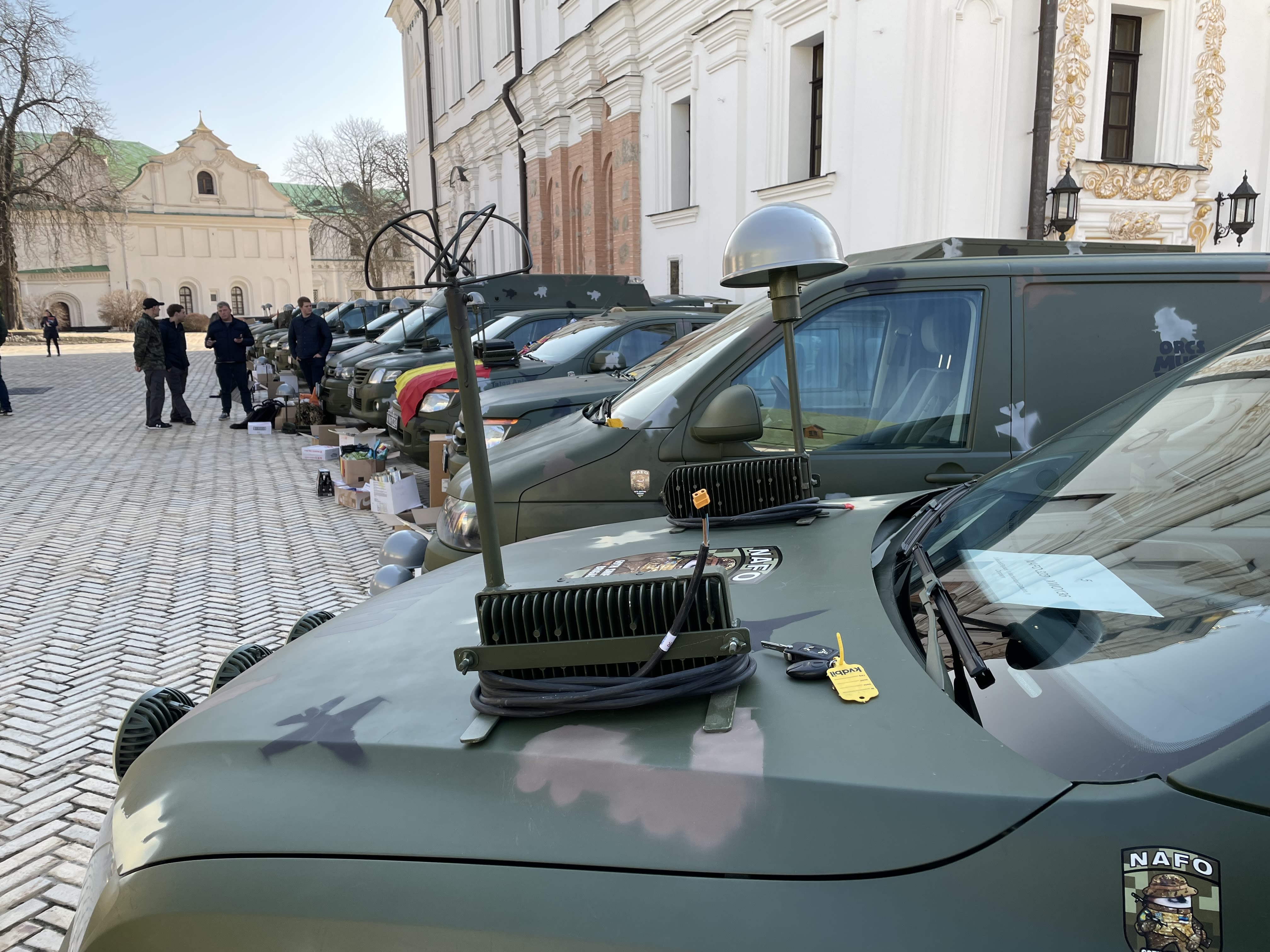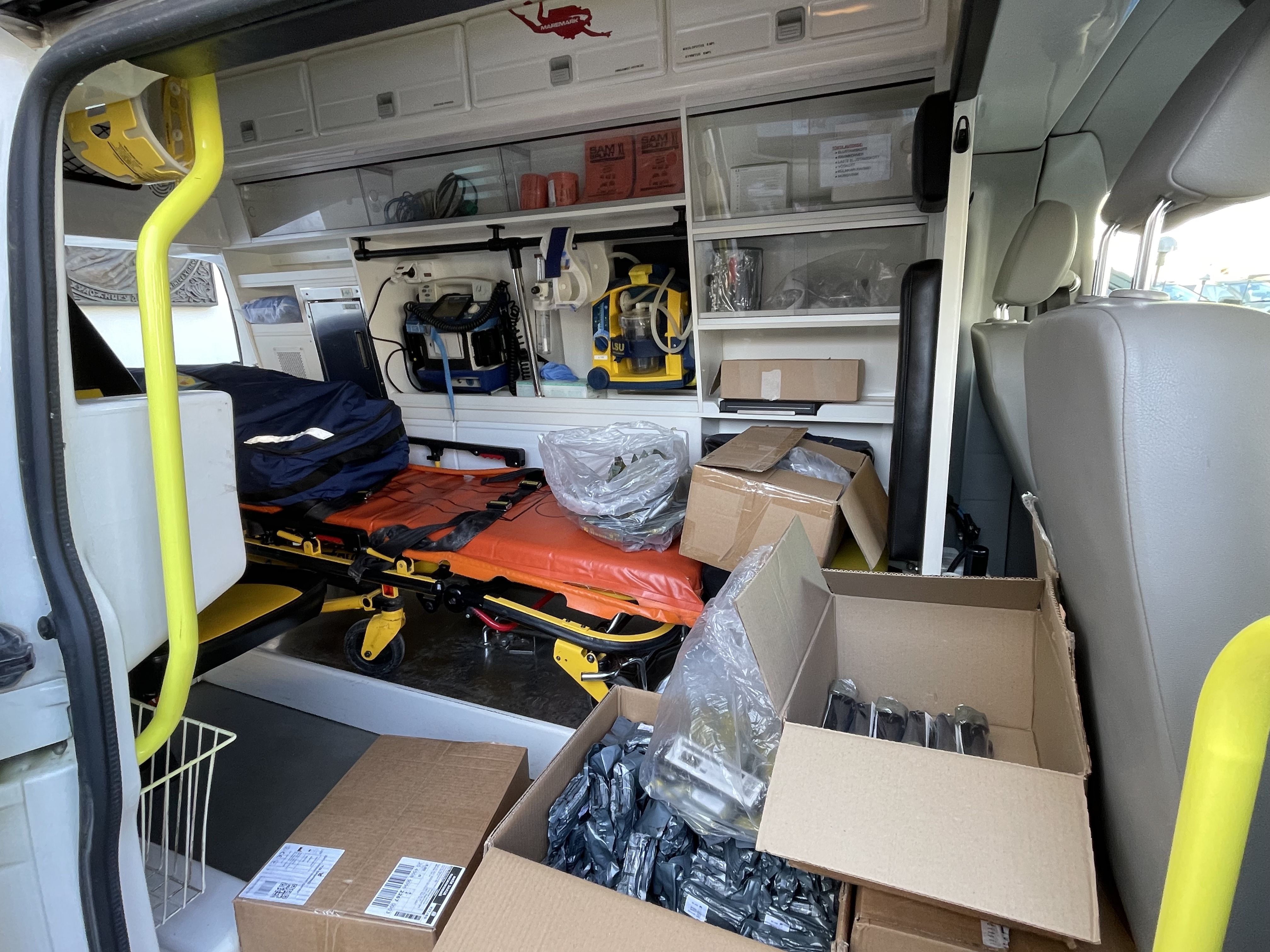The Freedom Convoy
The community of people delivering aid to Ukraine
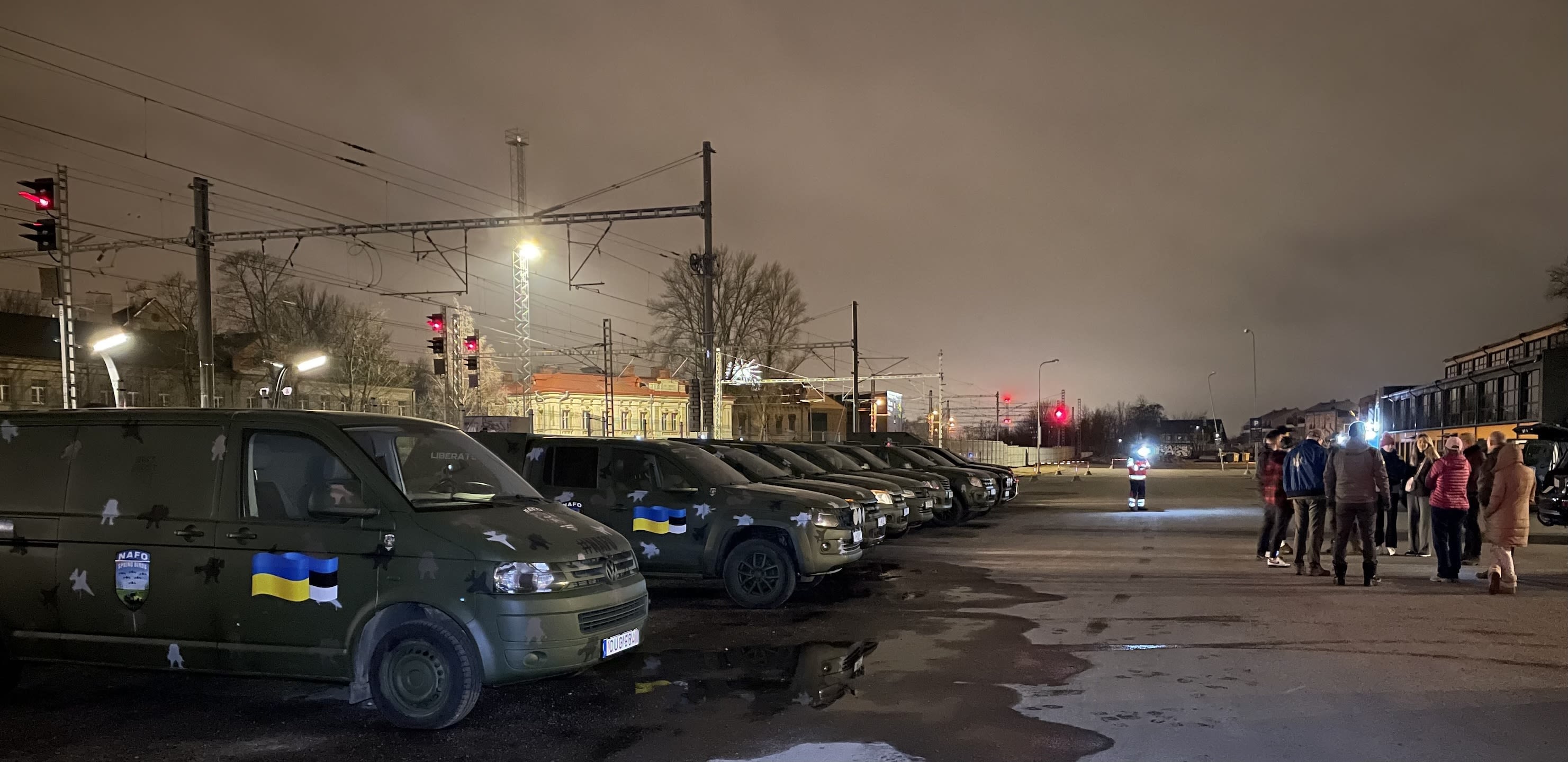
The air raid alarm wails on our phones as we wait for the Ukrainian border guard to let us through.
It’s 4am, there is a thick fog outside.
I’m sitting in the driver’s seat of a 4x4. Asleep next to me is a musician who owns a jazz café in Tallinn.
One of the drivers in the other truck posts a picture of the air raid alert map on our group WhatsApp chat.
Ukraine is on red alert.
Russian missiles are in the air.
A message pops up on our group chat: “Guess others also getting these air alarms – what’s the general approach with these?"
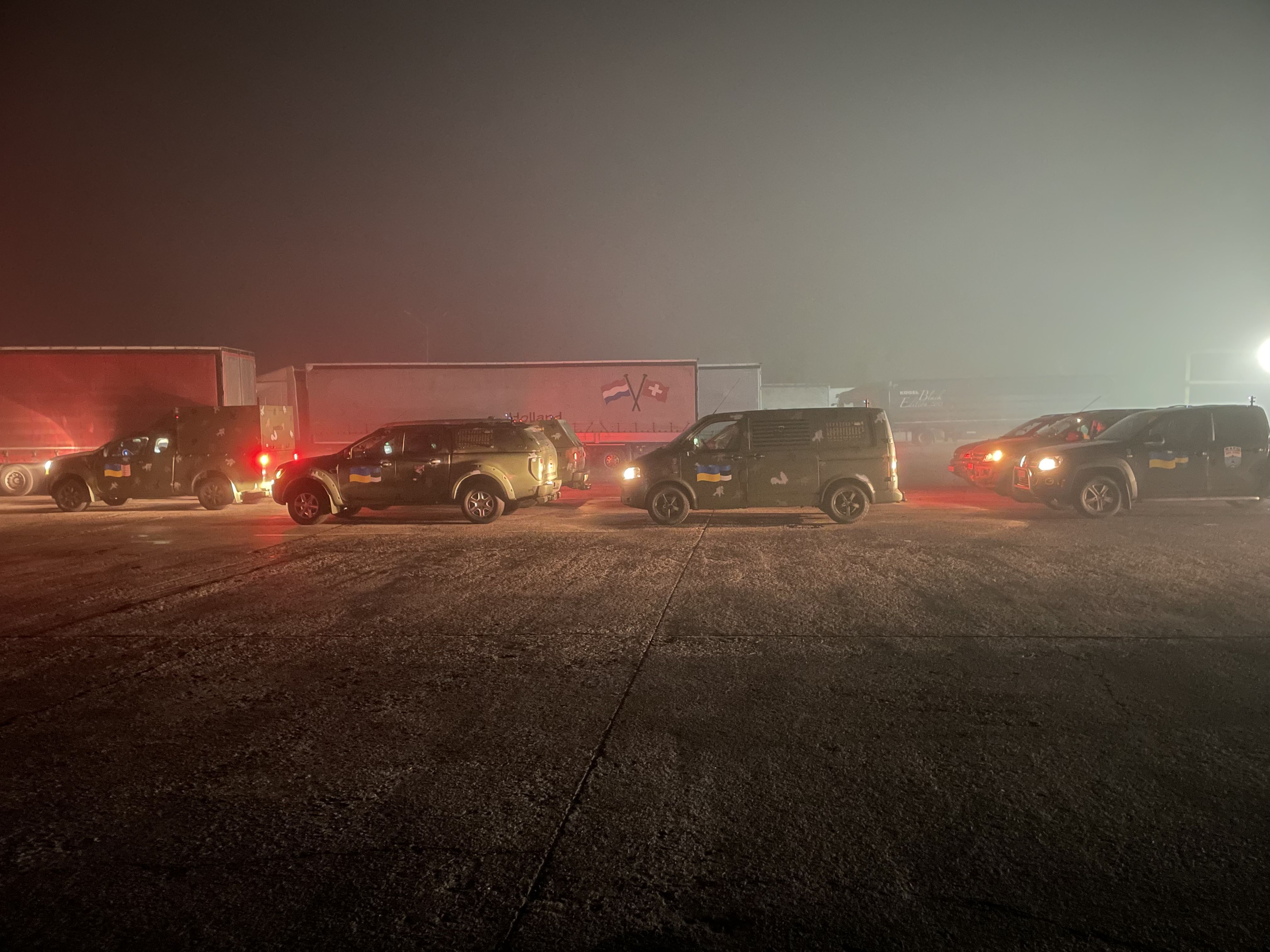
Split across the other vehicles is a retired Belgium who runs a flower festival on his family estate, a corporate PR executive, a retired German salesman, a venture capitalist, and Estonians who work in the tech and start-up sector.
Most have never been to a war zone before.
Someone else posts:
“What do you recommend? Wait til sunrise and then drive fast to Kyiv? Carry on in the fog during the air raid and stop if needed?”
“Keep driving, we’ll be ok,” Alex the convoy leader replies.
Viktoria, our Ukrainian fixer, adds: “Welcome to Ukraine.”
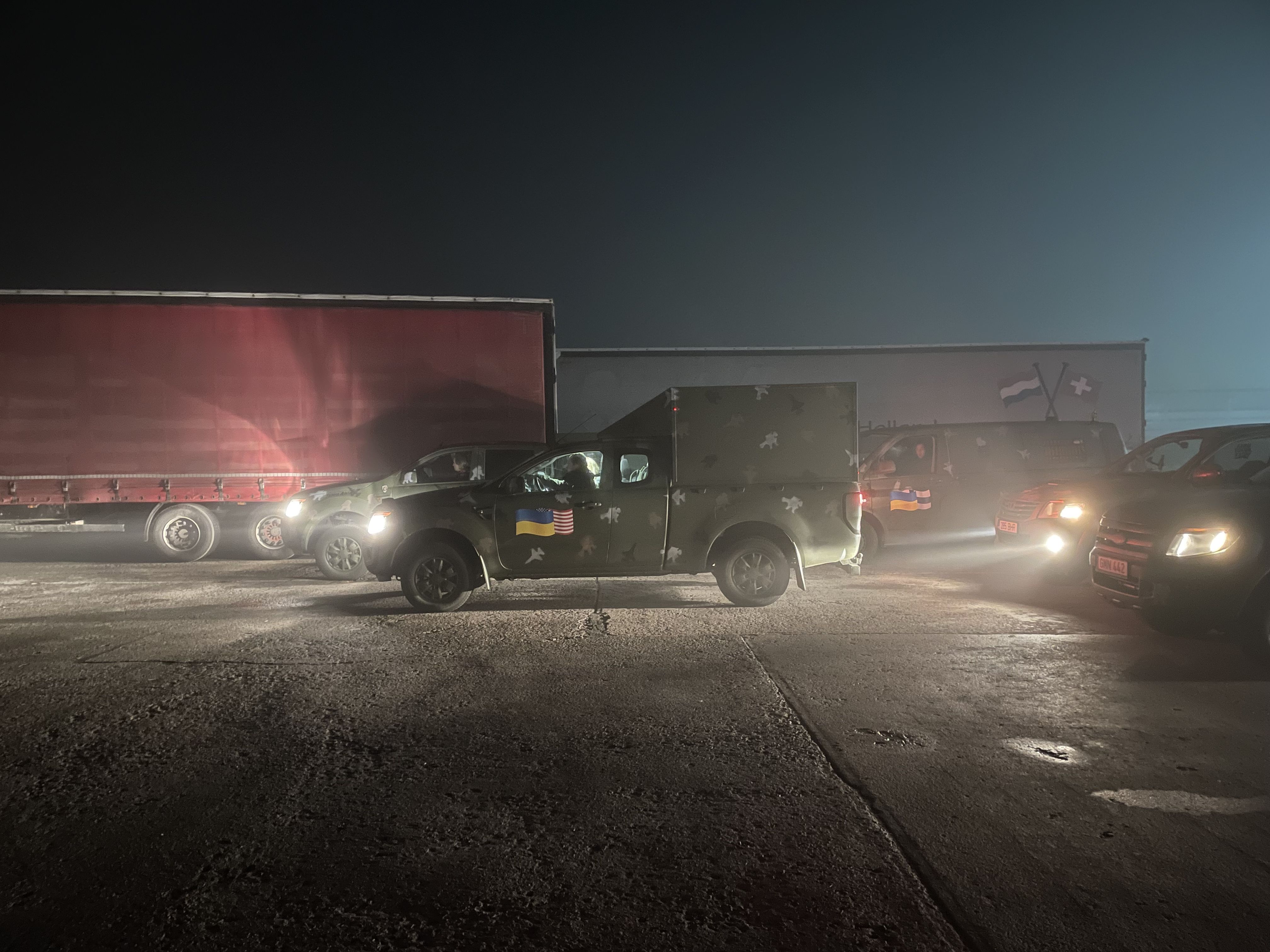
69th Sniffing Brigade, Estonia
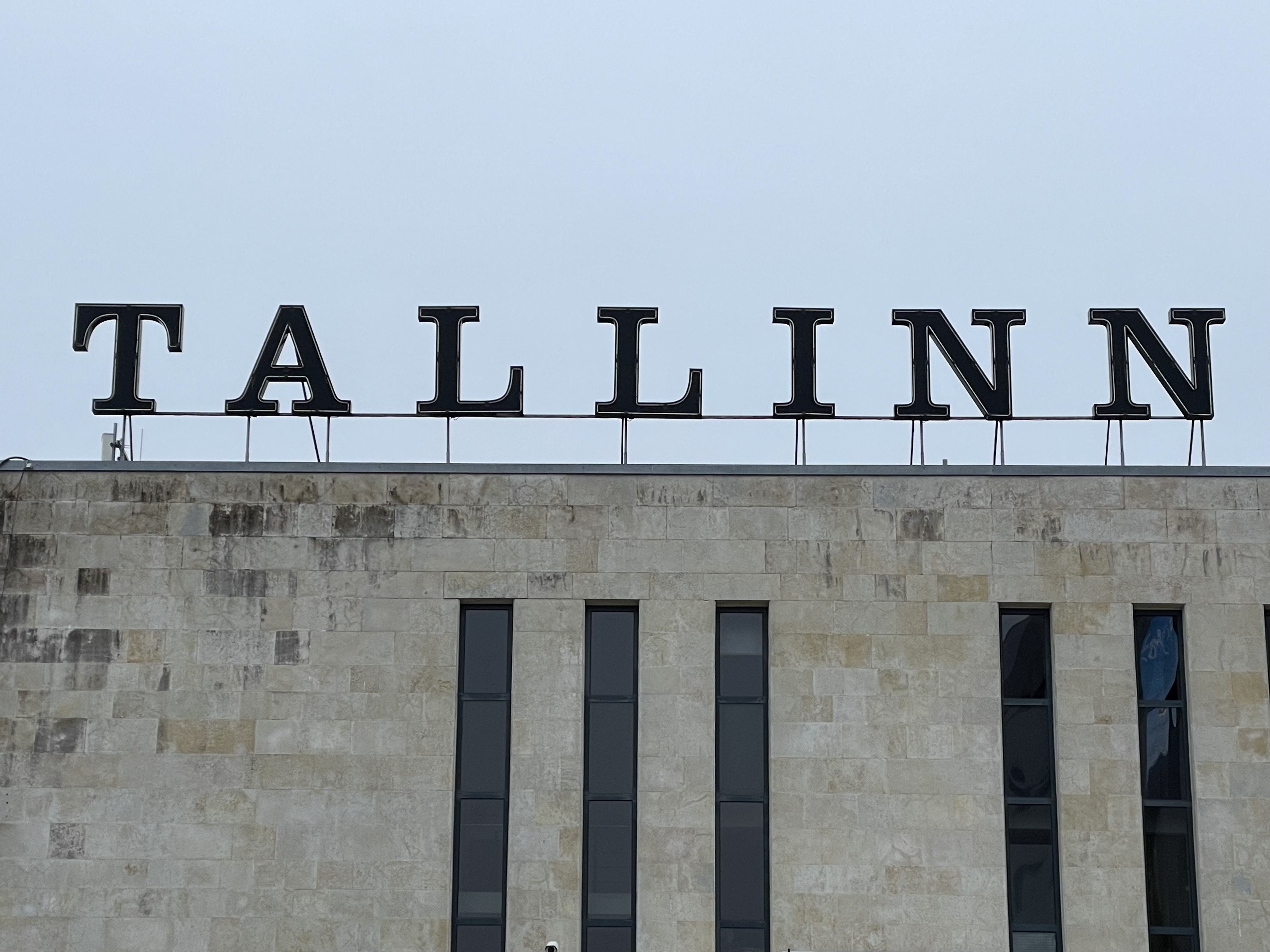
Twenty two hours earlier, on a cold dark morning in late March, 40 people gather at a parking lot in Tallinn, the capital of Estonia.
We are about to drive the 27th ‘Freedom Convoy’ of 20 vehicles, carrying 100 drones and medical supplies, 1,900km to Kyiv, Ukraine.
We are briefed on the route before we depart Tallinn.
We are briefed on the route before we depart Tallinn.
We are here because of Ragnar Sass, an Estonian tech entrepreneur one of the co-founders of the software company Pipedrive. In 2020 it was valued at over $1bn, the fifth Estonian startup to achieve this ‘unicorn’ status. Tallinn has become one of the most vibrant tech startups cities in Europe built on the successes of Skype, Bolt, TransferWise and Playtech.
Ragnar didn’t know anything about cars or convoys when Russia invaded Ukraine on February 24, 2022. Like many Estonians he was horrified and felt compelled to do something, anything.
The war started on the birthday of Estonia. They celebrate their national day on February 24. Estonia is a member of NATO and the EU, and borders Russia. Out of a population of 1.4m people, there are around 400,000 of Russian ethnicity. The war has stirred a deep unease about the future.
Two days after the full-scale invasion, 30,000 Estonians gathered in Freedom Square in Tallinn at a rally in support of Ukraine. It was the largest demonstration in Estonia since they regained their independence from the Soviet Union in 1991.
"'My friend is in Kharkiv on the frontline, his car broke, can you help him?’ I said, OK, fine.”
The 69th Sniffing Brigade patch with the NAFO dog.
The 69th Sniffing Brigade patch with the NAFO dog.
Ragnar had Ukrainian staff in Kyiv working at one of his companies, Lift99, a co-working space and incubator for tech startups. He helped them escape to Lviv, in the west of the country. He then spoke to friends and colleagues about what more they could do. “Two weeks later someone said to me, 'My friend is in Kharkiv on the frontline, his car broke, can you help him?'" Ragnar revealed. "I said, OK, fine.”
He looked online and bought the only vehicle he could think of for the job, a Toyota Hilux 4x4: “I wanted to give the car personally to the soldiers." He told other founders and friends in Estonia: "I will drive it personally to Lviv, I want to have a convoy and I will buy 5 more cars with my own money, who wants to join?”
People offered cars, financial support, bought aid supplies, and some said they would drive with him. Ragnar led the first ‘Freedom Convoy’ of 14 cars to Ukraine on March 26 2022.
Kyiv was still under siege, the borders busy with people trying to escape the country. “It was crazy,” he reflects.
When he returned to Estonia, he set up the Help99 website and the 69th NAFO Sniffing Brigade to crowd fund and deliver direct support to soldiers on the front lines. North Atlantic Fellas Organisation (NAFO), a play on NATO, is an informal online community that emerged through merciless mockery and trolling of Russian information operations and pro-Russian accounts. They post memes and videos, and used an image of a Japanese Shiba Inu dog as their mascot.
Most in demand are 4x4 vehicles. The army doesn’t have enough equipment so soldiers independently raise funds and source what they need.
Ragnar deals directly with individual soldiers and units in Ukraine, not the Army or Ministry of Defence. “When we fund raise, we are able to say, for example, you are helping to Anna, who is a in this unit. It has to be extremely personal. We need to provide our donors proof that it really is going to the right people,” Ragnar says.
Ragnar and his volunteer crew source vehicles from across Europe, repair them and fit them out to the soldiers’ specifications. “Whenever we get a unit contacting us, we really try and understand what they need, where they are, what is the situation,” he says.
Embodying NAFO’s satirical nature, the vehicles are painted in military green with a camouflage of silhouettes, an F16 fighter jet, a missile launcher, and the NAFO dog carrying an anti-tank weapon. All are weapons Ukraine says it desperately needs more of to fight Russia. On the windows is stencilled “ORCS MUST DIE!”. The Freedom Convoys have become memes on wheels.
"It has to be extremely personal. We need to provide our donors proof that it really is going to the right people.”
Camouflage of silhouettes: an F16 fighter jet, ACTAMS ballistic missile launcher, and the NAFO dog carrying a Javelin anti-tank weapon.
Camouflage of silhouettes: an F16 fighter jet, ACTAMS ballistic missile launcher, and the NAFO dog carrying a Javelin anti-tank weapon.
A NAFO meme on the side of the vehicle.
A NAFO meme on the side of the vehicle.
NAFO memes painted on the vehicles.
NAFO memes painted on the vehicles.
The vehicles have the flags of Ukraine, and the country where donations have come from.
The vehicles have the flags of Ukraine, and the country where donations have come from.
Those driving the 27th Freedom Convoy are a mix of people from across Europe and as far afield as Turkey, the U.S, and Bolivia. They all share a passion for Ukraine’s cause, but none were involved with Ukraine before the war. They all share a sense that this is a bigger fight.
Stefan, 65, is retired and this is his first convoy. He was born in the German Democratic Republic. As a university student he did an exchange year in St Petersburg during the Soviet Union: “I know the Russians, I know that if Ukraine does not win, the war will come to us, I don’t have children, but I have friends who do, and I know what will happen to Europe if we lose this.”
Renaud, 76, from Belgium, normally runs a twice-yearly flower festival on his family estate. He drove in his first convoy a year ago. “I’ve never liked or trusted Putin, so I had to do something to help,” said Renaud, who was a soldier during his national service. “My heart is with the soldiers; I have an affinity to those who serve.” This is his seventh convoy, he has paid for two 4x4s.
Florence, also from Belgium, is a senior manager in corporate PR. She has a husband and son. Looking back, she is embarrassed at how little she understood about Ukraine and the war. As the images of suffering filled the news, she followed Ukrainian mothers online whose sons were serving in the military, empathising with their perspective. Video of the Freedom Convoys popped up her feed: “I assumed these were guys with big connections, so I will never get there.”
Not long after she connected with Renaud on Twitter and realised that the convoys were open to those who contributed. She used to donate monthly to the traditional big NGO. Now she donates to the 69th where she can see the impact. Her first convoy was two months ago: “I was emotional, happy to do something bigger than myself.”
The power of the internet is that people no longer have to passively consume news nor rely on traditional NGOs to make a contribution. Intermediaries are increasingly unnecessary. People can take direct action. And for Ukraine, they do.
One of the vehicles painted and ready to drive to Ukraine.
One of the vehicles painted and ready to drive to Ukraine.
The core of the convoy remains the Estonian tech and startup community.
There are two generations, those who were born and lived under Soviet occupation, and those born after.
Jurgen, 49, owns a software company, has a wife and teenage son and this is his first convoy. His view of the threat to Estonia reflects many of the group born in Soviet times: “We understand this in our bones. Everyone in Estonia has a personal connection in their family to this history. Mothers, fathers, grandfathers, grandmothers, they have been through the "Russkiy mir" (Russian World), and they know what it is and what it brings.”
“It's very simple for us, that Ukrainians do what they do for all of us, all Europeans," he says.
Friends Birgit, 30, who works for an IT start up, and Helery, 31, who works for a tech investment fund, are the youngest members of the convoy, both born in a free and independent Estonia. For them, the war had changed their perspective of the future.
Helery decided to make the trip when she listened to someone who had driven on a previous convoy talk at a charity art auction in December to raise money. “One day Ragnar told me - now is your chance to go. I said yes," she recalls.
She told Birgit who replied: “I'm coming!”
“It was a three second decision,” said Birgit, who decided not to tell her mom. “She will know after I'm back,” she says.
The war has made the stories of Soviet occupation they grew up listening to more real. “We were generation for whom war was has always been a far topic, you see it in movies, but now it was in Europe, and the attacker was Russia,” Birgit says.
Helery agrees: "Even though we haven't experienced itself, it's like part of our DNA. We know that we don't want this and we have to do everything that we can to make it stop before it reaches us.”
The biggest change for Helery has been her perspective of the type of work she might do: “As an investor, my main goal has always been like, can we save the polar bears? And can we save the forest? And what can we do to find solutions to problems that help us all live a better life?”
Helery recalls the comments of an Estonian military officer at a tech conference in Tallinn. He was asked what three ideas the tech sector could work on to help Ukraine. “My first thought was that, okay, we're gonna talk about how to de-mine the country or rebuild schools or something," Helery says. His answer surprised her: "The military guy said, 'We need three things, guns that kill at 5, 10 and 50 kilometres,' and this just like, it made this really big switch in my mind. Everything that I have been working towards until now has to change if we want to be able to work on those things later."
Neither Helery nor Birgit are comfortable with the change, but as Helery reluctantly concludes: "I do see that it's really necessary to do it. We don't have the luxury in tech to say that I don't invest into defence tech, because I don't like shooting people, that moment has passed.”
For now, for both, the biggest anxiety is the 30-hour drive ahead.
“On Monday, I woke up, and I was just telling myself, there's only one big thing I need to do this week, which is just drive to Ukraine, because the car is the thing that we're bringing, and you can, like, fall asleep and crash it,” says Birgit.
They have packed their car with healthy snacks and a made playlist to get them through.
The Drive
After a briefing we set off, two people per vehicle, one drives, one sleeps.
We are led by Peeter and Alex. Both have driven multiple convoys. Alex, 39, from London, gave up his job as a manager in a sports company and moved to Ukraine to help.
Peeter, in his early 40s from Tallinn has a wife and young family. Classically Estonian, he doesn’t do small talk. He is direct and polite. He produces the art work adorning what come to be known as our ‘meme machines’.
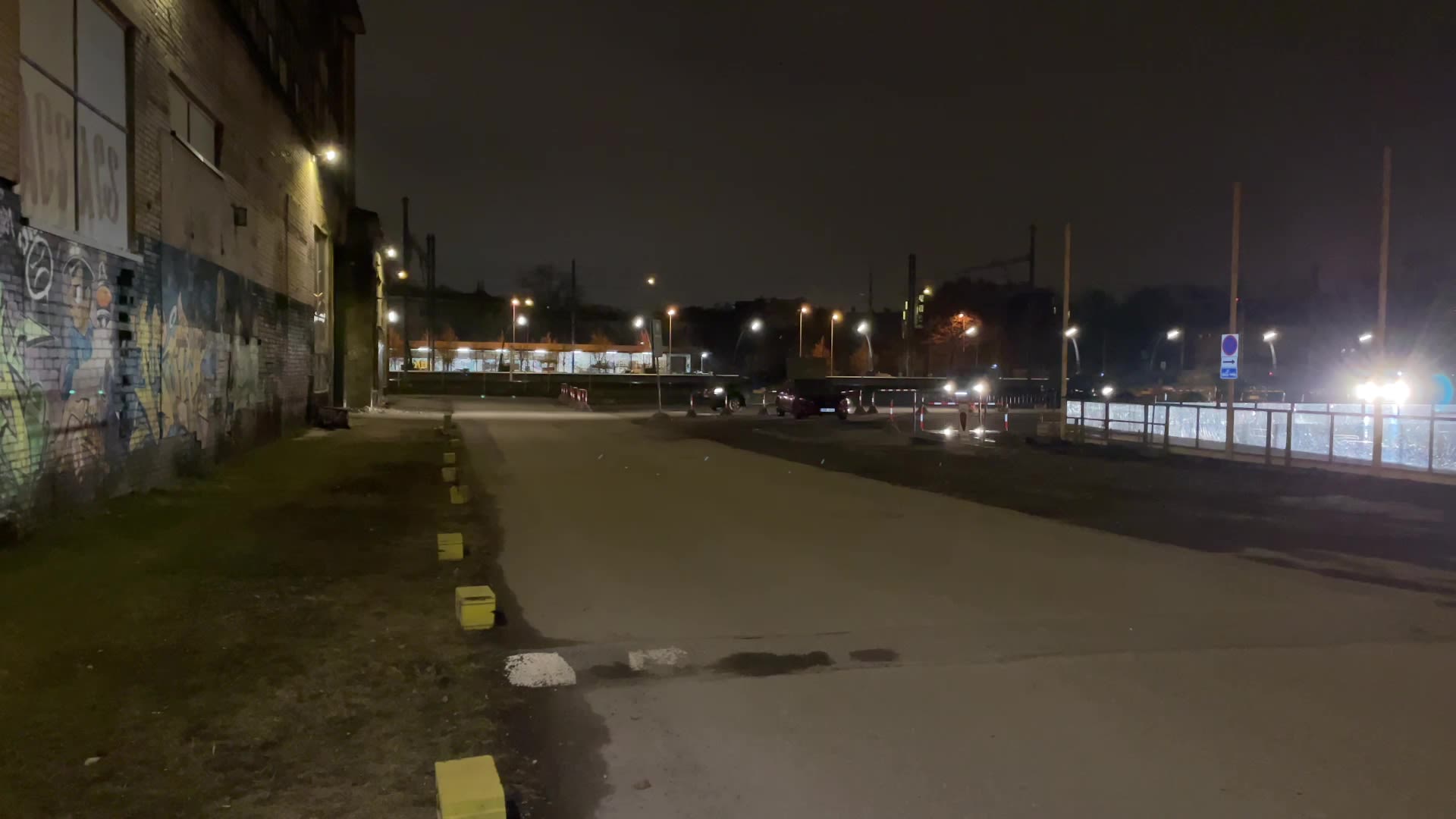
Each vehicle has a white LED on the front and a red one at the rear. We play 'chase the red light' as we try to keep up with Peeter in the lead vehicle.
We pass through the Baltics fast. The landscape is flat. The road a single carriageway all the way to Poland.
As we approach the Polish border, we pull over. The engine warning light is on in one of the 4x4’s. There’s a mechanic with the convoy. He connects his laptop to the engine and finds the fault. It’s driveable, so we push on.
By the time we get to the next stop, he has found the part needed, ordered it online, and it will be waiting for us when we arrive in Kyiv. Travelling in a convoy of tech start-up people means it is the most organised convoy I have travelled in. Nothing is left to chance.
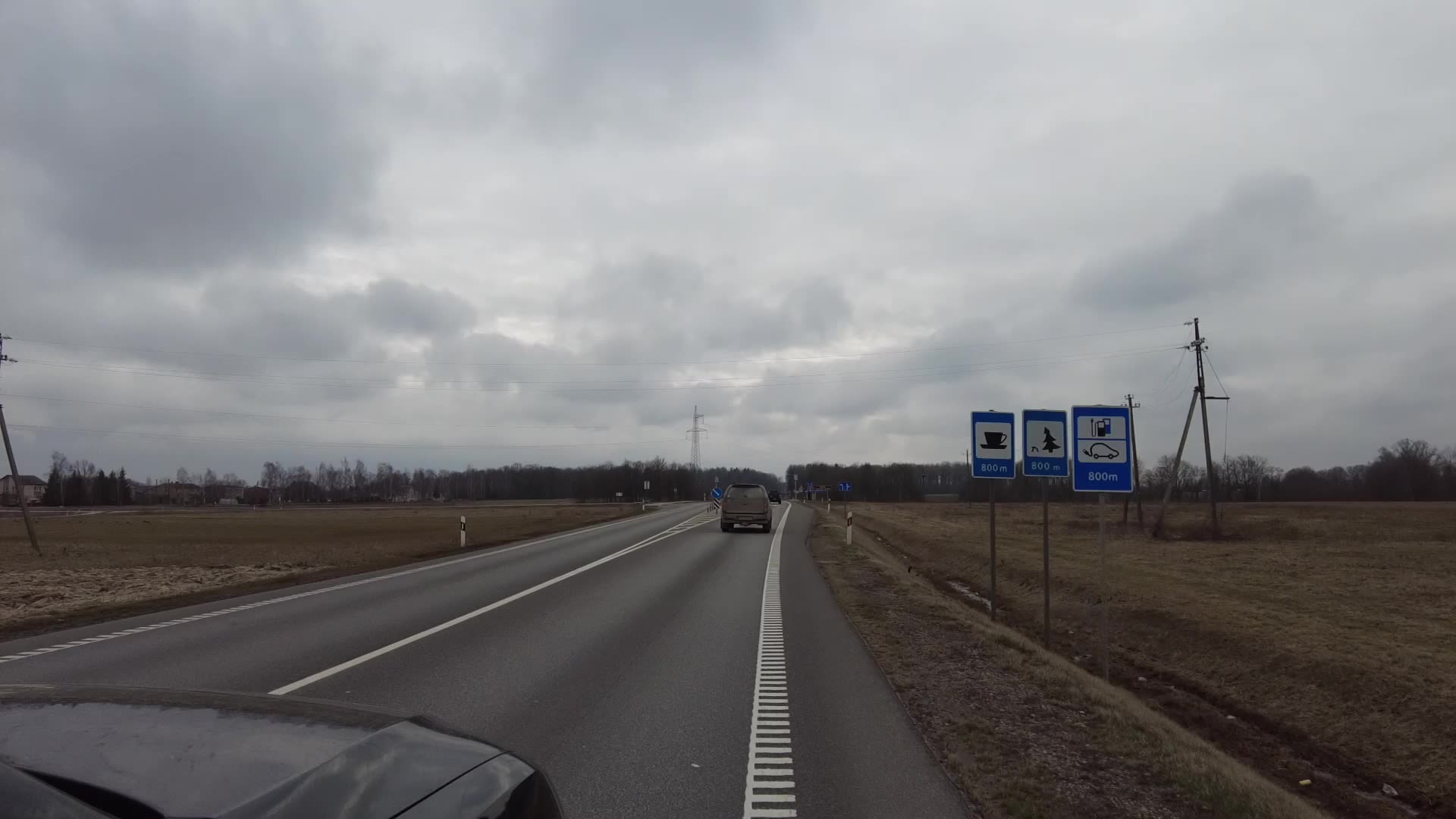
As we enter Poland, messages pop up on the group chat. Polish farmers are blockading every road in the east of the country in protest at 'cheap' food imports from Ukraine. There is a chance we might not get through.
We take a detour and weave through back roads and country lanes trying to find a way to the border.
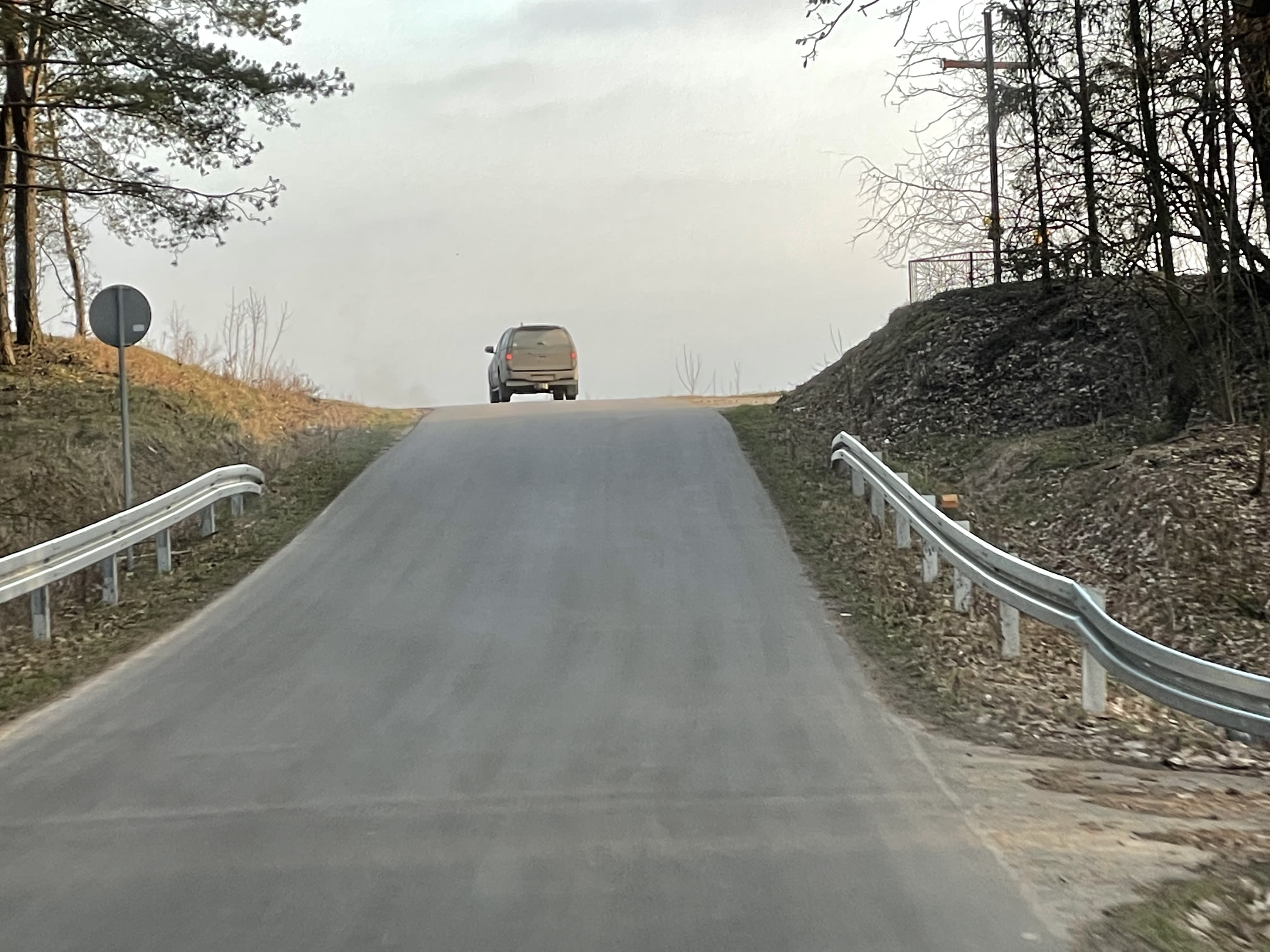
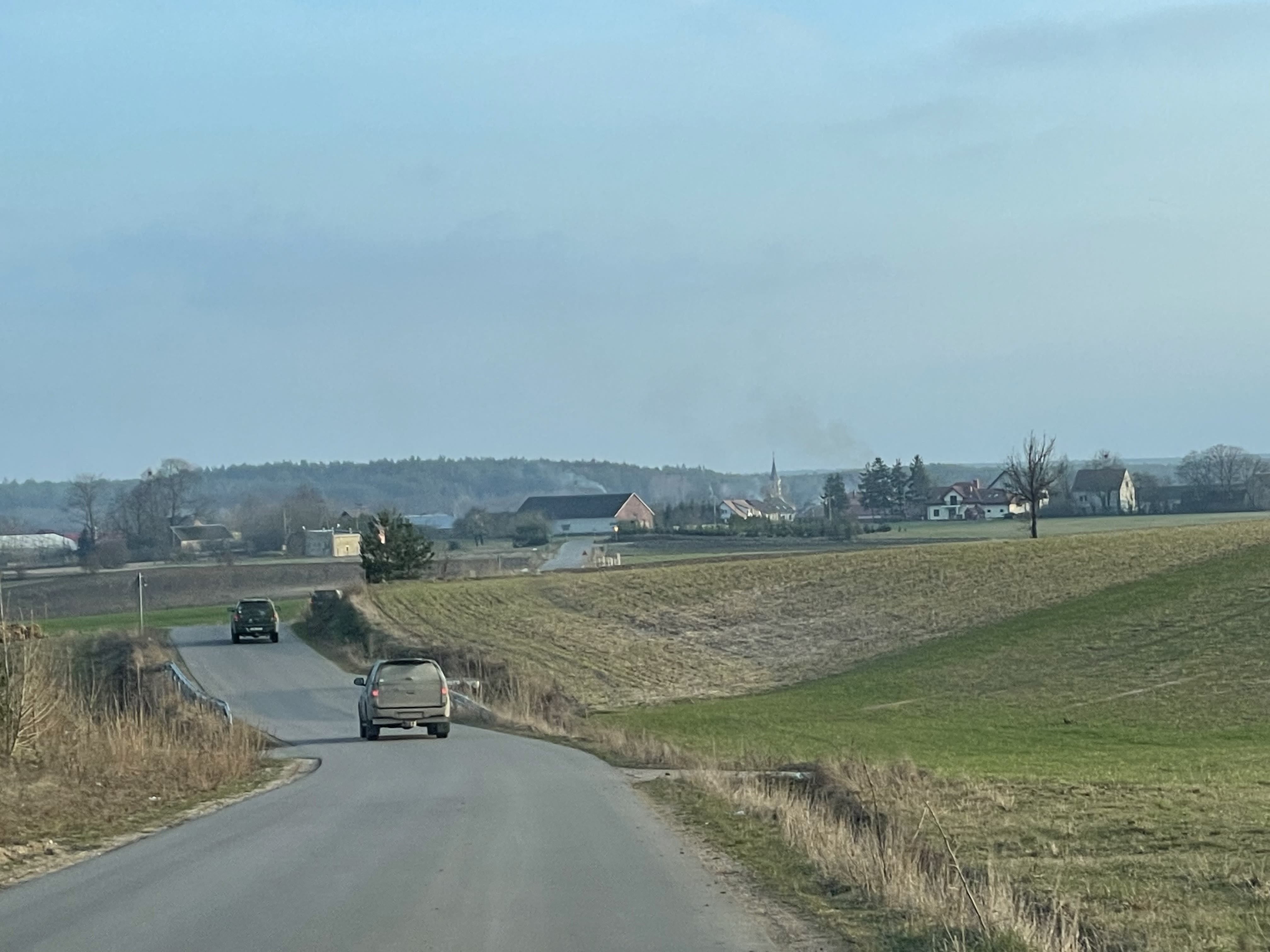
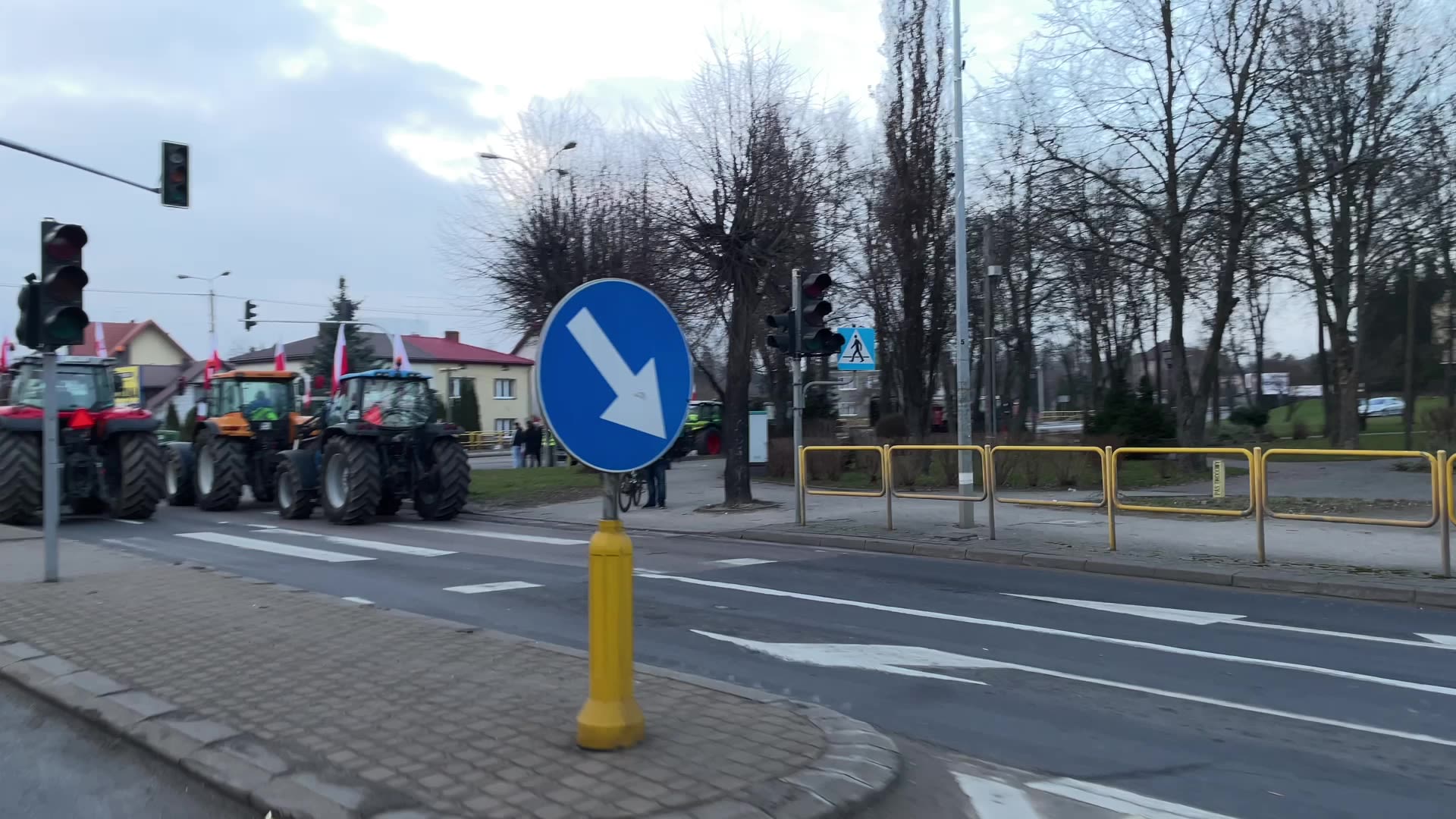
Finally, with no more back roads, we have no choice but to negotiate our way through.
The farmers aren't happy, but it is late and cold, and before they can change their minds, we drive through and race on to the border.
It is 3am by the time we cross.
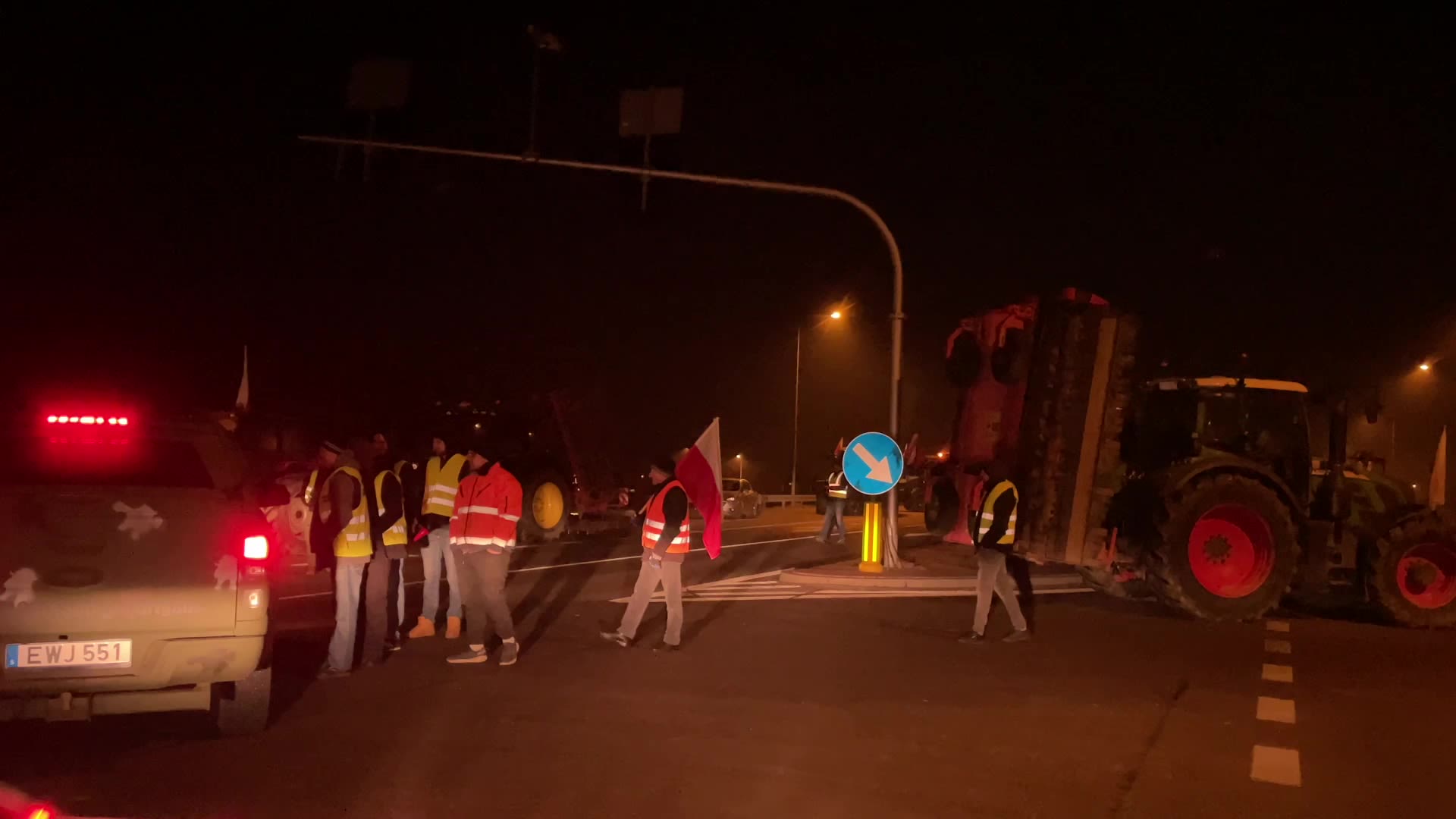
Ukraine
At the border with our phones alarming and vibrating to the sounds of the air alert, the guards take their time processing our paperwork. First time for us, another day at the office for them.
Alex recalls his first crossing a year ago: “It was a really weird feeling of being slightly excited, definitely slightly terrified, not quite sure of your life choices at that point. You drive into a war zone with military trucks thinking, ‘oh, this is an interesting idea,’ because you have no idea what it's like.”
We arrive in Ukraine as the situation is deteriorating. A few weeks before, Ukrainian forces withdrew from the city of Avdiivka, in the east.
Ukraine is running low on weapons, ammunition and soldiers. A shortage of air defence missiles means that more Russian drones and missiles are hitting the cities.
The US Congress has spent months arguing over whether to pass another aid package. If it is not passed soon, things could get rapidly worse.
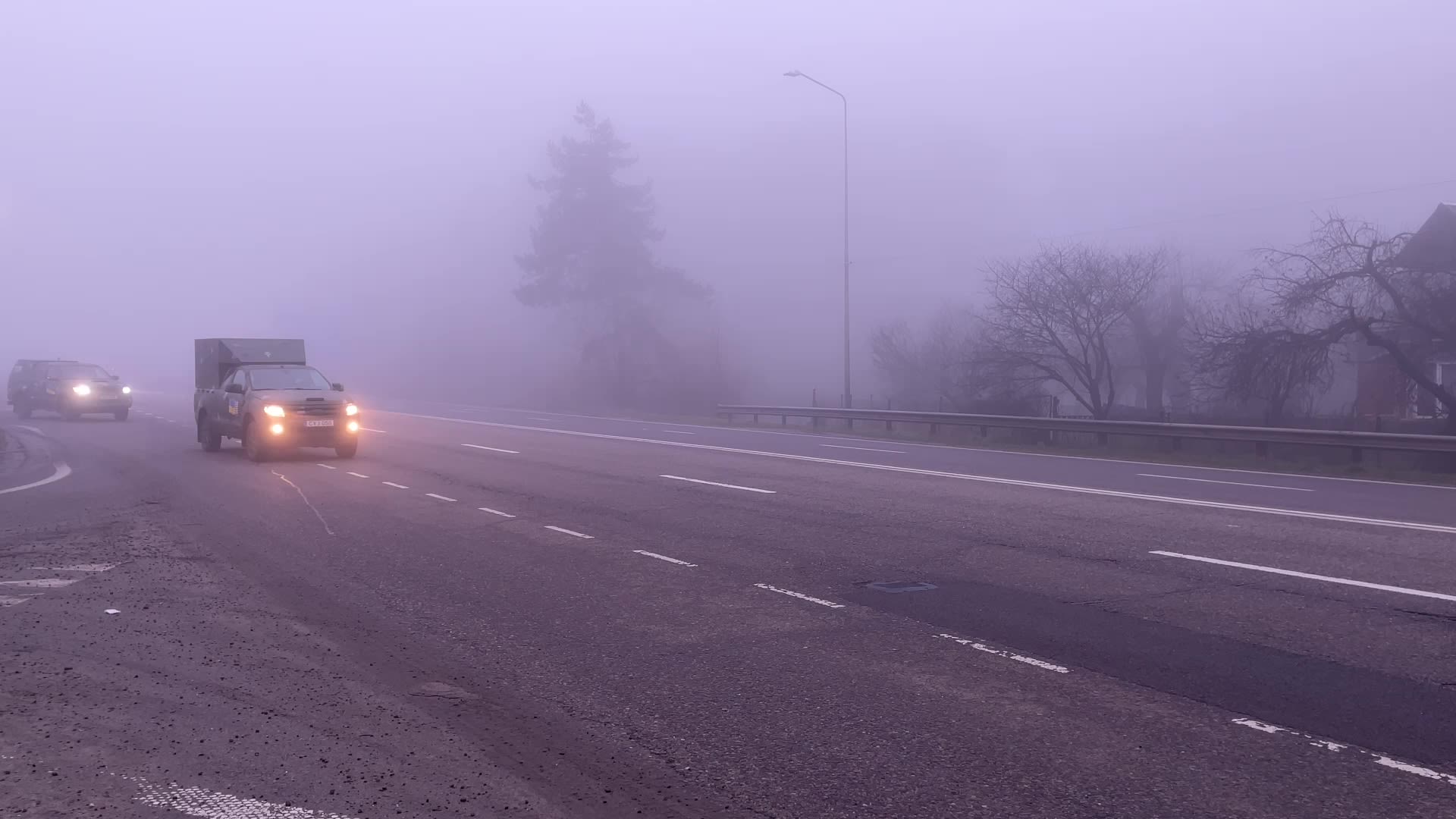
The sun is shining as Kyiv emerges ahead of us. We hit rush hour straight away.
At the start of the war the city mostly emptied. When the Russian Army withdrew from the north at the end of March 2022, the city slowly began to fill back up with both those returning home and those who fled from the east, making the city their new home.
Kyiv is beautiful and busy. There are no air raid alerts for our two days in the city. The gap gives it an almost surreal feeling. Ukrainians have filled the spaces between with as much life as possible. “It’s almost like there isn’t a war,” says one of the group, but then some soldiers walk past and there’s an embarrassed silence.
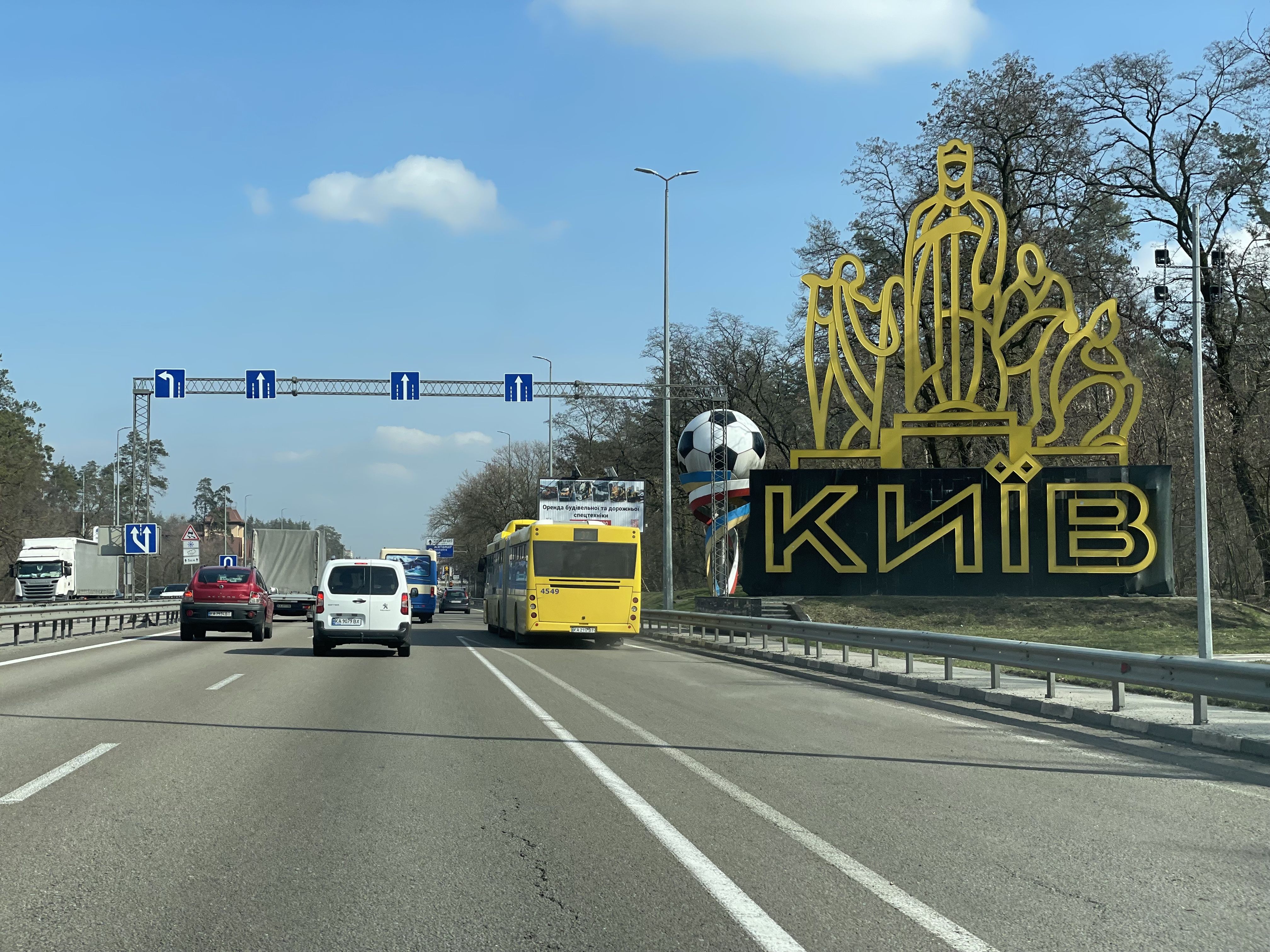
Handover
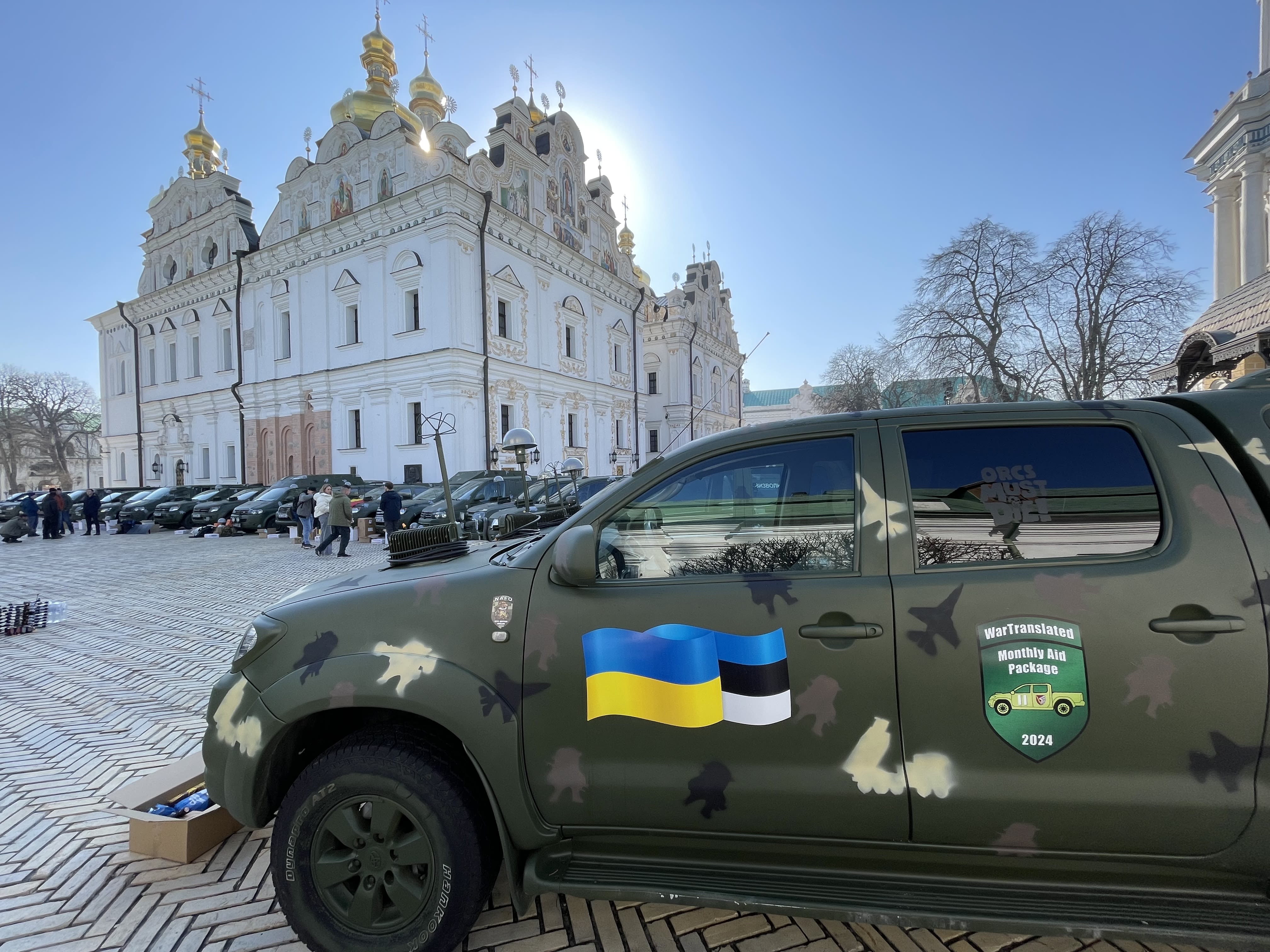
The next morning, we gather at Kiev Pechersk Lavra, a historic church and monastery with a cave complex beneath.
The vehicles have all been washed and the drones, medical kits and supplies of beef noodles, trench candles, chocolates, and Estonian liquor are all laid out, ready to be gifted.
The anti-drone jamming units are perched on the bonnets, looking like a prop from early Dr Who. No one actually knows how they work; just that you turn them on and they do.
The soldiers have arrived to collect the vehicles. Alex turns into compere for the cameras. Each soldier talks to us about their unit, what they do, why the kit being donated matters. It’s the polite version, suitable for the audience, but it also comes with clear messages: “We’re running out”, “We need more weapons”, “We’re fighting and dying so you don’t have to”, “Don’t forget us.”
To underline the point one of the soldiers presents an empty crate for artillery shells: “This was the last box, we’ve run out in my unit.” They tell us that kit donated has already saved Ukrainian lives and that what we donate today will save more, and so “will help kill and destroy Russians.”
As we work down the line, handing over each vehicle, people break away to talk to the soldiers. The soldiers thank us fulsomely, we thank them. It’s a moment of connection, questions, hugs, handshakes.
Renaud is on first name terms with the soldiers. He keeps in touch on WhatsApp between visits.
He starts asking them what else they need, making plans for his next convoy trip, working out dates so he can fit it around his flower festival. He gets his phone out and goes online to start fund raising.
They give Renaud a cushion with a picture of his face on and a unit flag signed by them, he beams: “I like that I know the names of who the truck and equipment go to, its important, you feel like you are doing something for another person.”
Renaud with his donations.
Renaud with his donations.
The cushion Renaud was presented with by the unit.
The cushion Renaud was presented with by the unit.
Collecting one of the 4x4s is Alex, 29, a drone pilot with the Ukrainian Army. His wife Natalia, 29, is with him.
Prior to the war, Alex and Natalia were both actors living near Bucha, an affluent suburb city just outside Kyiv. They had been childhood sweethearts, going to the same school and marrying at 19. Both performed at the National Theatre in Kyiv.
On the morning of the 24th February 2022, they woke up to the first missiles strike nearby. Natalia called her father who told them to pack the car and leave. In the panic they crashed into the wall at home, but escaped the next day and headed west. Their parents did not get out before the Russian occupied Bucha. After two weeks they returned to Kyiv to volunteer with local humanitarian groups. When the Ukrainian Army liberated Bucha a month later, what they found became synonymous with Russian war crimes.
Seven months into the war, Alex volunteered to join the army. Natalia also wanted to join but Alex did not want her to. “It's enough for one person from a family,” he says. Natalia continues to work as a volunteer, delivering aid and supporting the war effort.
Now Alex has one of the most coveted jobs in the Ukrainian military, a drone pilot. Every day he and his team hunt Russian soldiers and tanks with explosive drones. He runs his own Instagram and TikTok account, posting videos of his life as a soldier for his followers.
Alex, like many Ukrainians are increasingly pessimistic about the course of the war: “Half a year ago I was optimistic but if there’s gonna be progress we will have big problems, you know, because front frontline is moving every day towards us, towards Kyiv. We have haven't enough shells for artillery, that's the problem. In the summer it was okay but now it’s really hard.”
Over the past six months units have increasingly been asking for drones, and anti-drone jammers to stop the increasing number of Russian drones.
Last night, Kyiv, where Natalia lives, was attacked by Russian missiles and drones. “We can't do this with Russian people because we haven't got the weapons for this, but we can do it to Russian soldiers in frontline with the drones. You know, we haven't a lot of rockets, but we have drones and it saves us," Natalia says.
They record a brief video for his social media before driving off in the new 4x4. They have a day together before he has to head back east to the frontlines.
Alex, the drone pilot, says thank you to Alex, to the convoy leader, for the donations.
Alex, the drone pilot, says thank you to Alex, to the convoy leader, for the donations.
Stacks of new drones being donated.
Stacks of new drones being donated.
People gathering in front of the vehicles for the handover ceremony.
People gathering in front of the vehicles for the handover ceremony.
One of the 4x4s with the anti drone jammers on the bonnet.
One of the 4x4s with the anti drone jammers on the bonnet.
Two vehicles, one crowd funded in Estonia and one in the UK.
Two vehicles, one crowd funded in Estonia and one in the UK.
The Kraken Unit posing for a phot with two drivers.
The Kraken Unit posing for a phot with two drivers.
Anti Drone Jammers on the bonnet of a vehicle.
Anti Drone Jammers on the bonnet of a vehicle.
Inside one of the donated ambulances.
Inside one of the donated ambulances.
Anti drone jammers on top of the bonnet of a vehicle.
Anti drone jammers on top of the bonnet of a vehicle.
“I do it for their future.”
As we leave, people are already planning their next fundraiser and convoy. “The power of Help99 is the humour of NAFO, and the camaraderie,” says Renaud.
We are all tired, buzzing and emotional. I ask Helery about it: “It kind of makes you feel strange, because it seems like it's us that should be thankful and not them. So, it's kind of it's like a little bit cringe. Why are you thanking us? It should be the other way around!”
Three days later I’m having dinner at a friend’s apartment in Kyiv with the random assortment of people around the table. I tell them about the convoy. A Scottish farmer next to me laughs: “I’m doing exactly the same.” He raises funds among the farming community, buying 4x4 vehicles and driving them to Ukraine. In three weeks, he will deliver vehicles to Ukrainian friends on the frontlines in the east. He does this as often as he can.
Each week, since the first days of the war, groups of ordinary people from across Europe travel to Ukraine, delivering whatever vehicles, medical supplies, and aid they can. The Freedom Convoy is just one of many. Alone, they cannot sustain Ukraine. Only the industrial strength of governments can. However, these convoys are an expression of people's determination to do something practical to support Ukrainian soldiers.
As they get ready to catch the train back to Poland, I ask Peeter why he does this. He looks tired. He has a long trip home ahead of him, work on Monday morning and his family waiting for him. Next month, as he has done every month, he will lead another convoy from Estonia.
He pauses, looks at me directly, and says: “For my children. They are young. I do it for their future.”
A vehicle drives to the frontlines in the east.
A vehicle drives to the frontlines in the east.

